Samsung Electro Mechanics SWL-2300P 11 Mbps Wireless LAN PCI Card User Manual Manual Eng Rev1 0 SWL 2300M N P
Samsung Electro Mechanics 11 Mbps Wireless LAN PCI Card Manual Eng Rev1 0 SWL 2300M N P
User Manual

1
SAMSUNG
MagicLAN
SWL-2300M/N/P
User Manual (Rev. 1.0)

2
Table of Contents
1. MagicLAN Installation ……………...………..……………………………………...….10
1.1 Introduction ..………..…………………...……………………………………….…10
1.2 Technical Background ………………………………………………..………...…10
1.3 MagicLAN Overview….…………………...……………….….……….…..……....12
2. Before the Installation ………………………………………………………..……….....14
2.1 What is in your Package …………………………………………………….….…..14
2.2 System Requirement ……………………………………..…………………….…...14
2.3 Preparations For Installation……………………………..…………………….…...14
3. MagicLAN Installation for Windows 98SE/ME/2000/XP …………….15
3.1 Installation Overview ……………………………………….……………….……...15
3.2 Installation Procedure of Windows 98SE ………………..….………….…..….15
3.3 Installation Procedure of Windows ME ………………..….………….…..….22
3.4 Installation Procedure of Windows 2000 …………………………...……….28
3.5 Installation Procedure of Windows XP …………..………………...………..33
3.6 Update of MagicLAN Wireless LAN Card Driver…………….….…….…….......39
3.7 Removal of MagicLAN Wireless LAN Card Driver.….…….…….......39
4. The Program for setting MagicLAN..…….………………………...………..………..…41
4.1 The concept of Profile………………………………………….………..…..……..41
4.2 Installation Procedure…………………………………………………...….….41
5. The main configuration of Program……………………….….…………...…………....47
5.1 Profile……………………………………………...……………..……………….…48
5.1.1 The ‘New’ button………….…………………………………..…….……...48
5.1.2 The ‘Apply’ button…………..…………………………………...………...48
5.1.3 The ‘Edit’ button…………..……………………………………………..…48
5.1.4 The ‘Delete’ button………..…………………………………………....…..51
5.2 Status………………………...………………………………….……….…..…..….51
5.2.1 The ‘Current Status’ button……….………………………………...…......52
5.2.2 The ‘AP Status’ button..….…….………….………………………..……..52
3
5.2.3 The ‘Site Survey’ button…………………….……………………...……..53
5.2.4 Statistics………………...……….………………...…….….…....………..53
5.3 General Settings……………….………..…………...….……………..…….….……54
5.3.1 The ‘DHCP’ button…….………………………………………….…..….54
5.3.2 The ‘Options’ button…………………….…………………….……….….55
5.4 Version……………………………………………………….……………..…….55
6. Troubleshooting ………………………………………………......…….……….…….56

4
Notice 1
This manual cannot be reproduced in any form without the prior written permission of
SAMSUNG Electro-Mechanics Co., Ltd.
The users manual or instruction manual for an intentional or unintentional radiator shall caution the
user that changes or modifications not expressly approved by the party responsible for compliance
could void the user's authority to operate the equipment.
SAMSUNG Electro-Mechanics Co., Ltd. reserves the right to change this manual and the
specifications to improve products without prior notice. So you can get the most recent software
and user documentation for all MagicLAN products on our web site.
All other brand and product names are trademarks of registered trademarks of their respective
holders.
http://www.MagicLAN.com
Service Dept.
Young-sik Lyu (youngsik.you@samsung.com)
Tel : +82-31-218-2416 Fax : +82-31-218-2413
Sales
America
Eun-Sung Cho(echo65@samsung.com)
Tel : +82-31-218-2407 Fax : +82-31-218-2414
Europe
Yong-Il Kim (goodland@samsung.co.kr)
Tel : +82-31-218-2408 Fax : +82-31-218-2414
Asia
Seong-Mun Jeong (sungmun.jeong@samsung.com)
Tel : +82-31-218-2412 Fax : +82-31-218-2414
Copyright 1999 - 2002 SAMSUNG Electro-Mechanics Co., Ltd.
All rights reserved.

5
Notice 2
WARNING
While installing and operating this transmitter and antenna combination the radio frequency
exposure limit of 1mW/cm2 may be exceeded at distances close to the antennas installed.
Therefore, the user must maintain a minimum distance of 20 cm from the antenna.
Important Safety Information
l Read these simple guidelines. Breaking the rules may be dangerous or illegal. SAMSUNG will
not be responsible for any damages caused by breaking the rules.
l WLAN Card described in this document is approved for use in a wireless local area network.
l Remember to make backup copies of important data.
l When you are transferring data, keep your laptop computer stationary. Roaming between
access points (APs) may break the connection.
l Only qualified service personnel must repair the equipment.
l All wireless devices may get interference, which could affect performance.
l Use approved accessories only. Do not connect incompatible products.
l Use only accessories approved by the WLAN Card manufacturer for use with this particular W
LAN Card. The use of any other types will invalidate any approval or warranty applying to the
WLAN Card, and may be dangerous.
l Use only the region settings appropriate for the area where the WLAN Card is used at the
present time. Using the card in any other region or with an incorrect region setting is prohibited
and may be illegal.
l Operation of any radio transmitting equipment, including a WLAN Card, may cause interference
with the functionality of inadequately protected medical devices.
l Do not use the WLAN Card on aircraft.
l Do not use the WLAN Card at a refueling point.
l Do not use the WLAN Card near inflammable materials or chemicals.
l Do not use the WLAN Card where blasting is in progress.
l Do not use the WLAN Card when the use of wireless device may cause interference or danger.
l Do not use the WLAN Card where the use of cellular terminals is prohibited.
l Microwave oven degrades the performance of wireless LAN drastically. So do not use the
WLAN card in the environment where Microwave oven is being used.
6
This device complies with Part 15 of the FCC Rules. Operation is subject to the following two
conditions: (1) this device may not cause harmful interference, and (2) this device must accept any
interference received, including interference that may cause undesired operation.
CAUTION: Changes or modifications not expressly approved by the manufacturer responsible for
compliance could void the user’s authority to operate the equipment.
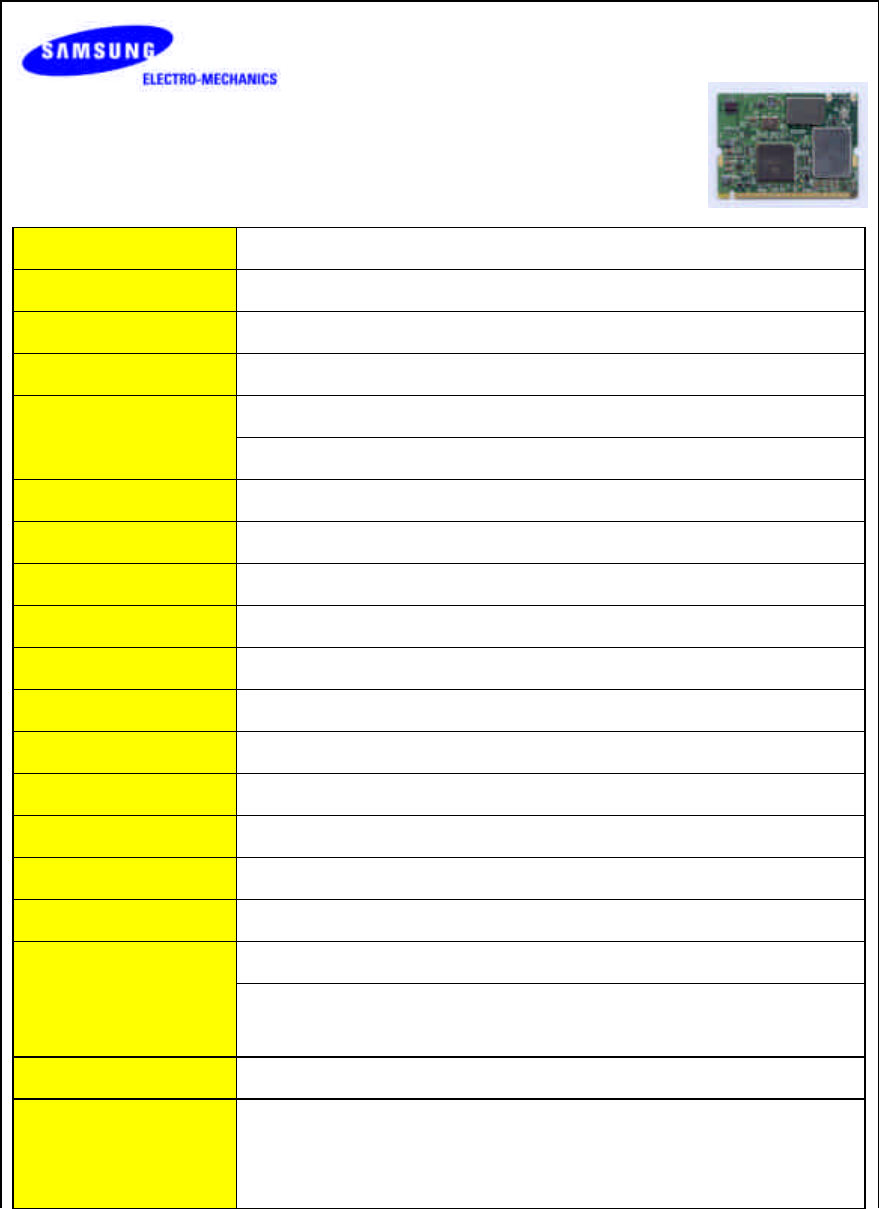
7
11Mbps High Rate 802.11b Wireless LAN MiniPCI Card
Specifications
Model Name SWL-2300M
System Interface MiniPCI Spec 1.0 (Type 3B Form Factor)
Frequency Band 2.400 ~ 2.4835GHz(Subject to local regulations)
Operating Voltage 3.3Vdc (±5%)
Receive mode : 315mA (Typical)
Current Consumption Transmit mode: 360mA (Typical)
Data Rate 1, 2, 5.5 or 11Mbps
Spreading DSSS(Direct Sequence Spread Spectrum)
Output Power 15dBm(mW) for 22MHz Bandwidth
Receive Sensitivity -86dBm at 11Mbps (Typical)
Security 40-bit/104(128)-bit WEP Encryption
Antenna Connector SMT Ultra Miniature Coaxial Connector 2 pieces
Available Drivers Microsoft Windows 98SE/ME/2000/XP/CE
Standards IEEE 802.11b
Media Access Protocol
CSMA / CA (Carrier Sense Multiple Access with Collision Avoidance)
Temperature Range Operating : 0~55(32~131), Storage : -20~70(-4~158)
Humidity 10% to 90% Non-condensing
Operating Range Open Space : 150m(500ft) at 11Mbps, 200m(660ft) at 2Mbps
(1024 bytes file
transfer)
Office: 30m(100ft) at 11Mbps, 50m(160ft) at 2Mbps
*Range differs by environment
Dimensions 59.6 ラ44.6 ラ5.0
Certifications
&
Regulatory Approvals
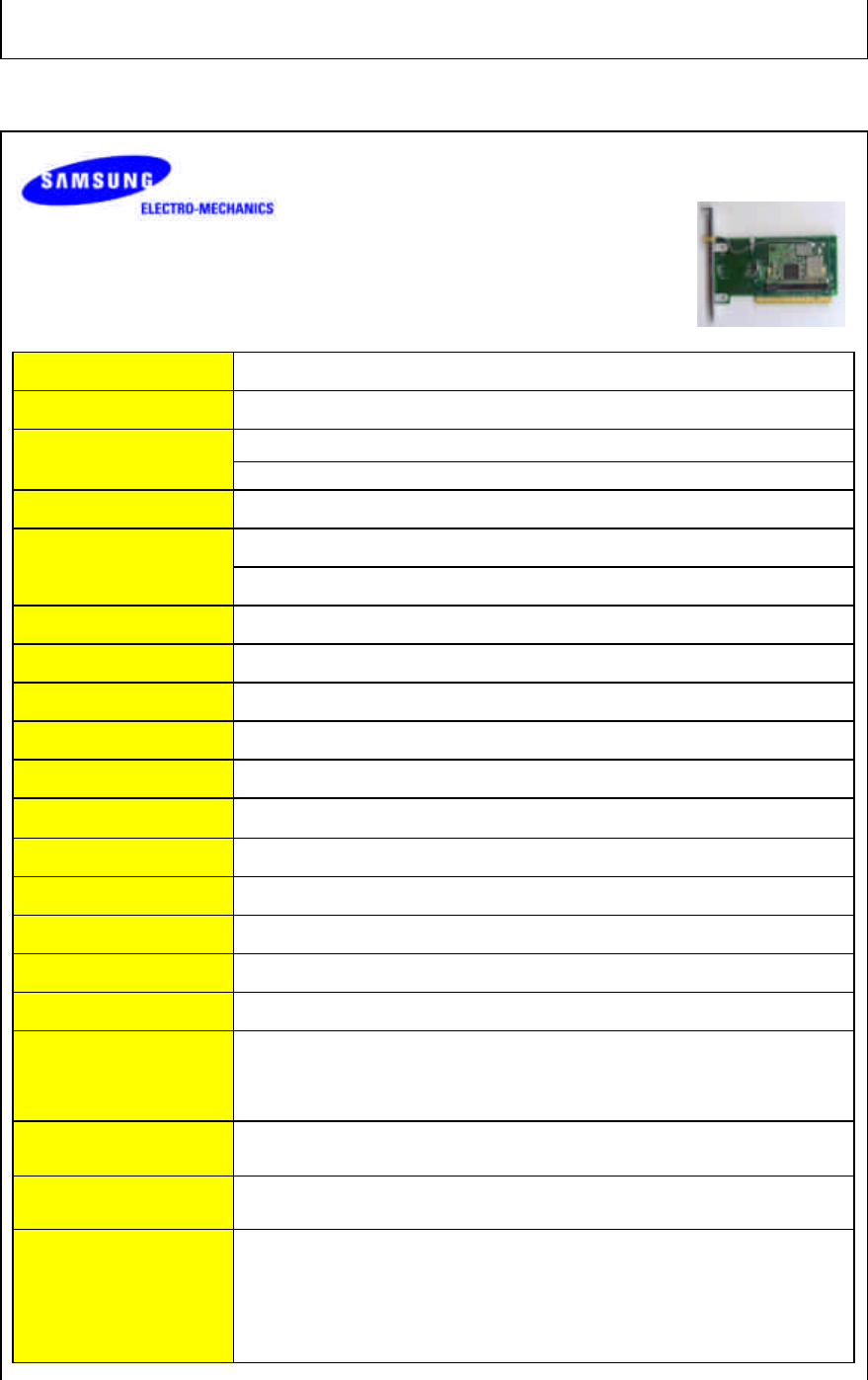
8
CopyrightSamsung Electro-Mechanics Co., Ltd. All Rights Reserved.
11Mbps High Rate 802.11b Wireless LAN PCI Card
Specifications
Model Name SWL-2300P
System Interface PCI Spec 2.2
2.400 ~ 2.4835GHz(Subject to local regulations)
Frequency Band 1∼11ch(U.S and Canada), 1∼13ch(ETSI), 1∼14ch(Japan)
Operating Voltage 5V ±5%
Receive mode : 315mA (Typical)
Current Consumption Transmit mode: 360mA (Typical)
Data Rate 1, 2, 5.5 or 11Mbps
Spreading DSSS(Direct Sequence Spread Spectrum)
Output Power 15dBm(32mW) for 22MHz Bandwidth
Receive Sensitivity -86dBm at 11Mbps (Typical)
Security 40-bit/104(128)-bit WEP Encryption
Antenna External 5dBi Patch Antenna with left-turn SMA connector and 1.5m
cable
Available Drivers Microsoft Windows 98SE/ME/2000/XP/CE
Standards IEEE 802.11b
Media Access Protocol
CSMA / CA (Carrier Sense Multiple Access with Collision Avoidance)
Temperature Range Operating : 0~55(32~131), Storage : -20~70(-4~158)
Humidity 10% to 90% Non-condensing
Operating Range
(1024 bytes file transfer)
Open Space : 150m(500ft) at 11Mbps, 200m(660ft) at 2Mbps
Office: 30m(100ft) at 11Mbps, 50m(160ft) at 2Mbps
*Range differs by environment
Dimensions 126.8 ラ70.0 ラ18.0
Weight 65g
Certifications
&
Regulatory Approvals

9
CopyrightSamsung Electro-Mechanics Co., Ltd. All Rights Reserved.
11Mbps High Rate 802.11b Wireless LAN PC Card
Specifications
Model Name SWL-2300N
System Interface CardBus Spec 7.0
Frequency Band 2.400 ~ 2.4835GHz(Subject to local regulations)
Operating Voltage 3.3V±5%
Receive : 245mA (Typical), Transmit : 310mA (Typical)
Current Consumption Power Save: 40mA (Typical)
Data Rate 1, 2, 5.5 or 11Mbps
Spreading DSSS(Direct Sequence Spread Spectrum)
Output Power 40mW(16dBm) for 22MHz Bandwidth, 7mW/MHz
Receive Sensitivity -86dBm(Typical) at 11Mbps
Security 40-bit/104(128)-bit WEP Encryption
Antenna Dual antennas supporting diversity
Available Drivers Microsoft Windows 98SE/ME/2000/XP/XPSP1/CE
Standards IEEE 802.11b
Media Access Protocol CSMA / CA (Carrier Sense Multiple Access with Collision
Avoidance)
Temperature Range Operating : 0~45(32~113), Storage : -25~70(-13~158)
Humidity 10% to 90% Non-condensing
Operating Range Open Space : 150m(500ft) at 11Mbps, 200m(660ft) at 2Mbps
(1024 bytes file
transfer)
Office: 30m(100ft) at 11Mbps, 50m(160ft) at 2Mbps
*Range differs by environment
Dimensions 109mmx54mmx5mm
Certifications
&
Regulatory Approvals
Wi-Fi certified
Korea

10
CopyrightSamsung Electro-Mechanics Co., Ltd. All Rights Reserved.
**** Table: The Operating Channels
Channel Frequency FCC Canada ETSI Spain France Japan
1 2412MHz
2 2417MHz
3 2422MHz
4 2427MHz
5 2432MHz
6 2437MHz
7 2442MHz
8 2447MHz
9 2452MHz
10 2457MHz
11 2462MHz
12 2467MHz
13 2472MHz
14 2484MHz

11
1. MagicLAN Installation
1.1 Introduction
Thank you for your purchase of SAMSUNG MagicLAN. Installing this cards allow the computer
to join a wireless network based on the IEEE 802.11b (High Data Rate) WLAN standard. You
will be surprised how easy for you are a part of the network with no bother of twisted cables.
1.2 Technical Background
• What is IEEE 802.11?
The IEEE 802.11 specification is a wireless LAN standard developed by the IEEE (Institute of
Electrical and Electronic Engineering) committee in order to specify an over an air interface
between a wireless client and a base station or Access Point (AP), as well as among wireless
clients. Like other IEEE 802 families, IEEE 802.11 specification addresses both Physical (PHY)
layer and Media Access Control (MAC) layer.
• IEEE 802.11 Physical (PHY) Layer
At the PHY layer, IEEE 802.11 defines three physical characteristics for WLAN: diffused
infrared, direct sequence spread spectrum (DSSS), and frequency hopping spread spectrum
(FHSS). While the infrared PHY operates at the baseband, the other two PHYs operate at the
2.4GHz ISM (Industrial, Scientific, and Medical) band, which can be used for operating wireless
LAN devices without the need of end-user licenses. In order for wireless devices to be
interoperable, they have to be conforming to the same PHY standard.
• IEEE 802.11 Media Access Control (MAC) Layer
The IEEE 802.11 MAC Layer is mainly concerned with the rules for accessing the wireless
medium. There are two network architectures defined: Ad-hoc Network and Infrastructure
Network.
• Ad-hoc Network
Ad-hoc Network is an architecture that supports mutual communication among wireless clients
only. Since Ad-hoc Network does not support access to wired networks, it does not need an
Access Point to be a part of the network. You can use the network immediately after setting up
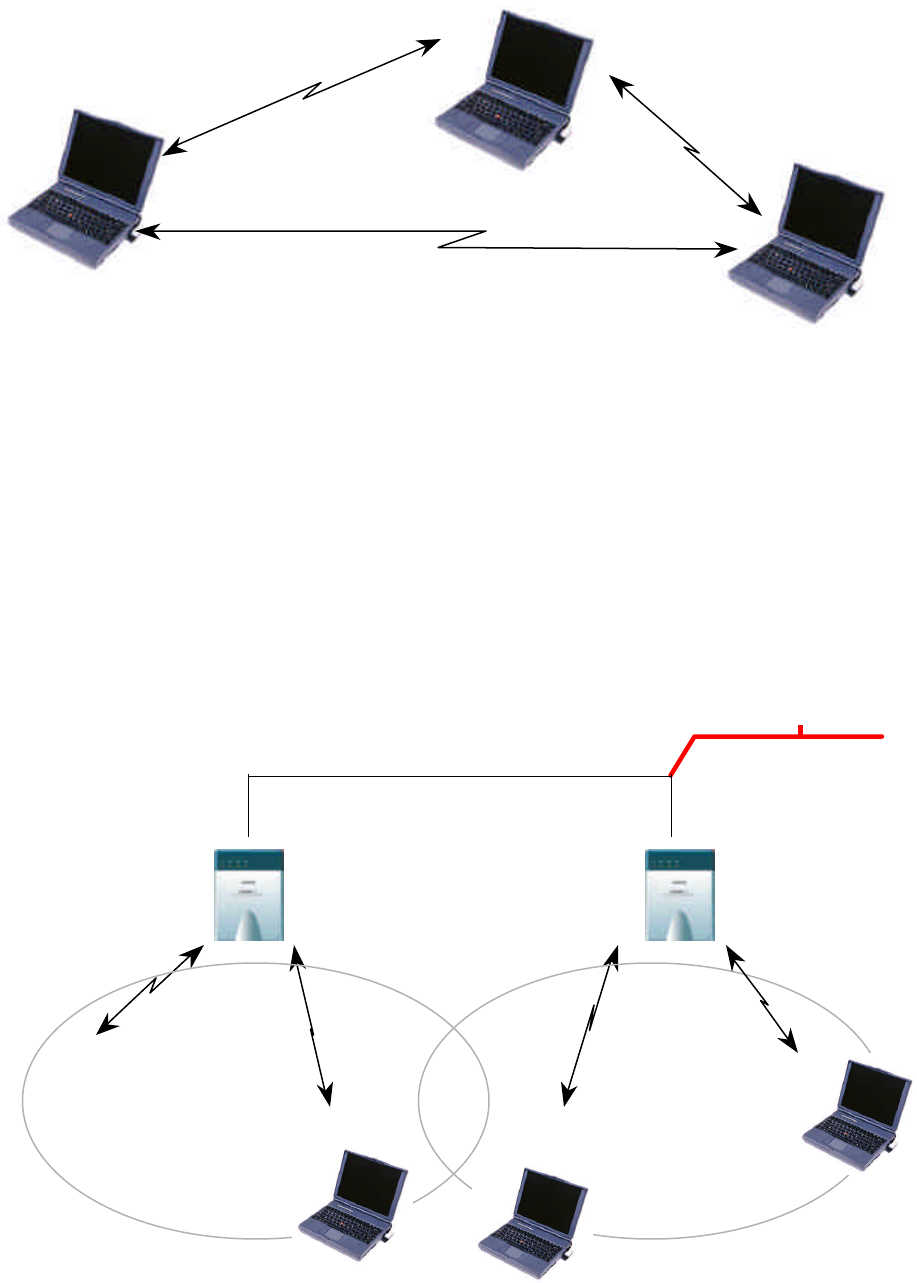
12
the operating mode by installing the supplied network driver.
• Infrastructure Network
Infrastructure Network is architecture that provides communication between wireless clients and
wired network resources. An Access Point (AP) and the associated wireless clients define the
transition of data. So a wireless client can access all the services that are available for a regular
wired LAN by using an AP.
BSS BSS BSS BSS
Serve
Server

13
• Roaming
Roaming is a service that allows wireless clients to use the network in motion by automatically
changing the connection from an old Access Point to a new Access Point when the clients enter in
a new cell. During roaming the clients may observe the loose connection or delay in accessing the
resources of the network.
• Scanning, Beaconing & ESS ID
When a wireless client is initialized, it is necessary for it to find and communicate with the correct
group of wireless devices, including AP. At this point, it may search for all the frequency channels
and this process is called scanning.
There may be multiple APs and networks operating at the same time. It may be necessary to
ensure that the station joins with the correct network during the scanning process. To achieve this,
each AP is assigned to be part of a logical group called the Extended Service Set (ESS). The
name of this logical group is the ESS ID. When roaming is operating, there may be several Access
Points as part of the same ESS.
After the power on, wireless clients will listen on its default frequency channel. It will be listening
for beacons sent by another wireless station or AP. Beacon is a short message containing the ESS
ID that will be broadcast roughly ten times a second. When the wireless station hears a beacon
and the ESS ID in the beacon matches its own, the client knows that it is on the correct channel
and can communicate with its group. If no beacons are seen, or if the ESS ID does not match, the
wireless client may move to the next frequency channel and repeat this listening procedure.
In case of direct sequence spread spectrum (DSSS) physical layer, this scanning process occurs
at start up and may also occur when the client roams between APs.
1.3 MagicLAN Overview
• The MagicLAN SWL-2300M/N/P(MiniPCI/PCMCIA/PCI Card) are wireless LAN adapter
cards that provide wireless connection between computers.
• The MagicLAN is designed to operate with IEEE 802.11 (wireless LAN International
Standard) wireless compliant radio cards and uses a CSMA/CA (Collision Sense Multiple
Access with Collision Avoidance) algorithm as the media access scheme, which makes high speed
communication (with minimal collision probability) possible.

14
• The MagicLAN supports DSSS (Direct Sequence Spread Spectrum) physical layer. This is a
radio technique, which scrambles the data prior to transmission and uses a correlation technique
on receiver to improve the signal to noise ratio and makes it possible to communicate in the office
having a wall and a compartment.
• The function of the MagicLAN Access Point is to transfer information from a wired LAN to a
wireless LAN and vice versa. When operating, the MagicLAN AP is invisible to most users
(Normally, unless the user is an administrator, the MagicLAN AP cannot be seen or accessed by
users on the network).
• The SWL-2300M/N/P both for Laptop PC and Desktop PC is small and portable as a
roaming function is provided for users who need network services while maintaining mobility.
• The MagicLAN supports various network software. The network driver is provided to support
network software such as Windows 98SE,ME, Windows 2000, Windows XP, Windows CE.
• To get further information of Samsung MagicLAN WLAN Card, please visit our website at
http://www.magiclan.com to download the respective drivers.

15
2. Before the Installation
The following section will assist you in installing your WLAN Adapter successfully. You will install
the SWL-2300M/N/P Card and software(driver & utility), and finally set the network properties
to accommodate resource sharing and select the type of wireless network that you wish to install.
The MagicLAN can easily be installed and used, without bothering to connect cables for keeping
your computer to use network resources, as in case of a wired LAN.
2.1 What is in Your Package?
Please check the contents of the box to make sure everything is included and ready for use. Here
is the list of what you should have in your package:
• SWL-2300M/N/P(MiniPCI/PCMCIA/PCI Card)
• External Antenna (SWL-2300P)
• Samsung MagicLAN Installation CD
2.2 System Requirement
• Operating System: 98/98SE,ME, Windows 2000, Windows XP, Windows CE
• Computer System (both Laptop and Desktop) with a CD-ROM drive
• For Desktop PCI Card (SWL-2300P):
The computer system should have PCI slot.
• For Laptop MiniPCI Card (SWL-2300M):
The computer system should have MiniPCI Type slot.
• For Laptop Cardbus Card (SWL-2300N)
2.3 Preparations For Installation
You have to prepare Installation CD which is provided by manufacturer.
You can just install SWL-2300M/N/P cards to use Ad-hoc network.
You need to install Access Poing(AP) to use Infrastructure network.(Refer to the AP
Manual about the installation method of AP)
You may need the original CD of (Windows 98SE,Windows ME, Windows 2000,
Windows XP) to set network environment.
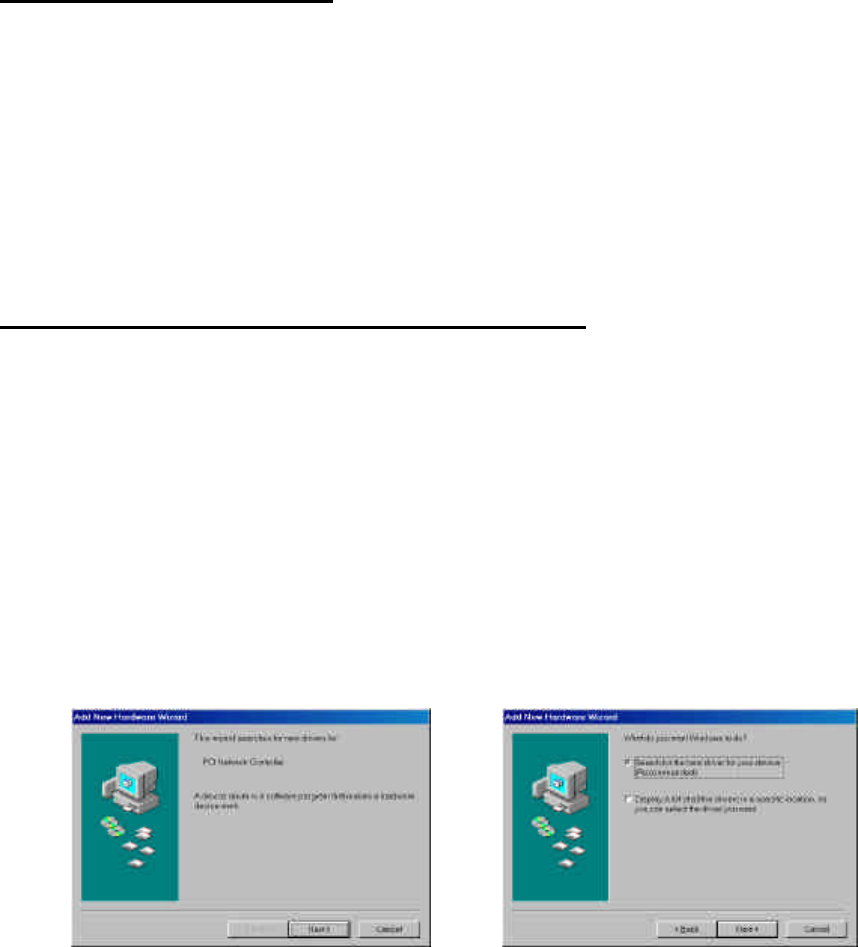
16
3. MagicLAN Installation For
Windows 98SE/ME/2000/XP
We will explain the installation method for SWL-2300M/N/P (MiniPCI/PCMCIA/PCI Card) .
3.1 Installation Overview
Here are some steps you will perform in establishing your wireless network connection:
1. Install the Access Point at first. AP is needed in case of Infrastructure network mode.
2. You should install the Wireless LAN Card (SWL-2300M/N/P).
3. Install the software using the Installation CD.
4. Install the network protocol(s) required to communicate on your network. Most likely
you will need the TCP/IP protocol.
3.2 Installation Procedure of Windows 98SE
Please follow the following steps one by one to install the MiniPCI/PCMCIA/PCI card
successfully.
< Method 1 - Inserting card first >
1. Insert the MiniPCI/PCMCIA/PCI Card into the slot of your computer.
2. Power on your computer and allow Windows 98SE to load fully.
3. “Add New Hardware Wizard” appeared and the system looks for “PCI Network
Controller”. Press ‘NEXT’ button and check if “Search for the best driver for your
device(recommended)” is selected and then press ‘NEXT’ button . Insert the MagicLAN
Installation CD into the CD-ROM drive.
4. Mark the “Specify a location” tap and type “E:\Drivers” right below in this tap(Where
E is the CD-drive of your PC) and then press ‘NEXT’.
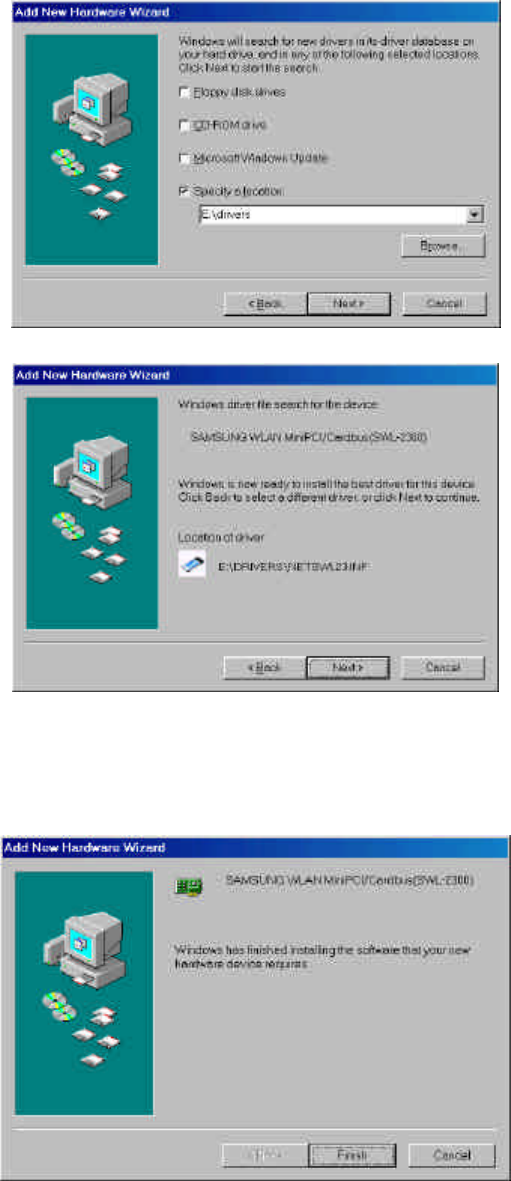
17
You can find the “SAMSUNG WLAN MiniPCI/Cardbus(SWL-2300)” and now it is
ready to install our software.
5. Press ‘NEXT’ and system will copy driver files. You may require Windows 98 CD.
Now driver files are fully installed to start the Wireless LAN Card’s operation.
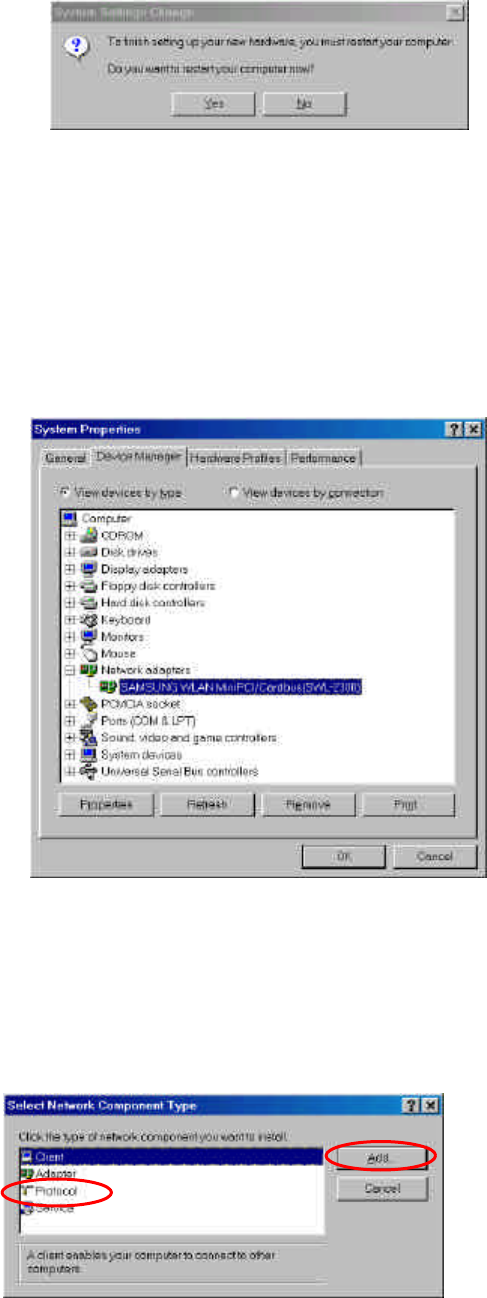
18
If screen message ‘Do you want to restart your Computer now’ will pop up,
select Yes.
6. After rebooting your computer, right click on the My Computer using the mouse and
click Properties.
7. Check for the SAMSUNG WLAN MiniPCI/Cardbus(SWL-2300) by clicking on the
Device Manager. If you find the Yellow sign on the adapter, it shows the installation is
not successful. Select the Adapter and click on Remove. Restart your computer after
uninstalling the driver. (See the Adapter Removal in section 3.7)
8. Right click on the Network Neighborhood using the mouse. Select Properties
from the pop up menu. The network box appears and you see three main tabs:
Configuration, Identification and Access Control.
9. Click on the configuration tab and then click on the add button. Select Network
Component Type box appears. Click on the Protocol then click the Add button.
10. Select Network Protocols box appears. From the list of manufactures, click on
Microsoft. From the list of network protocols list, select IPX/SPX and TCP/IP, then click
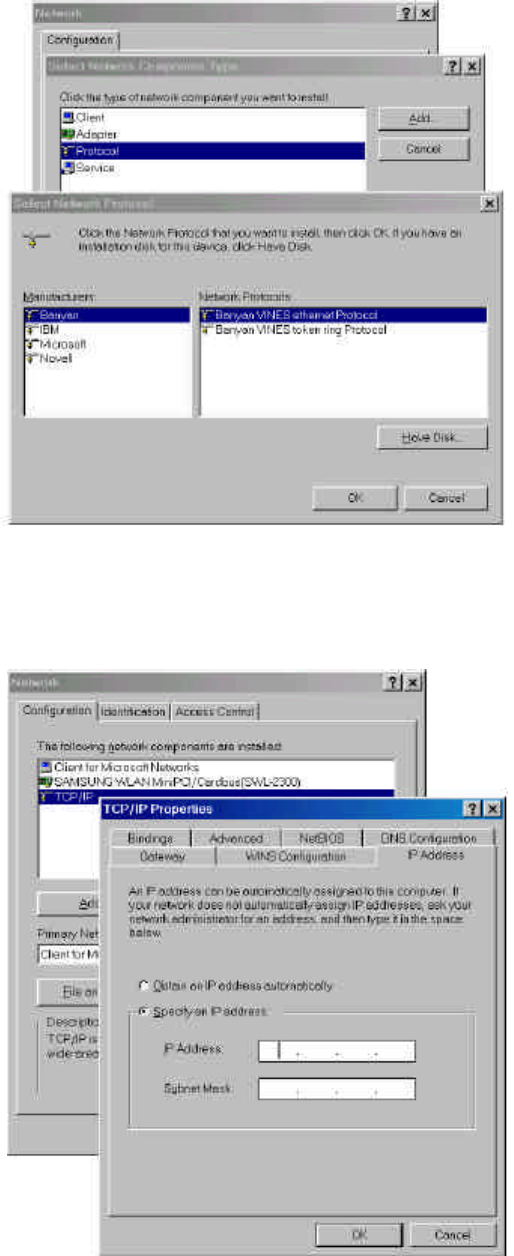
19
OK.( If you want, you can install the NetBEUI protocol.)
11. Select the TCP/IP option for setting the IP address value, Gateway value and DNS
value of your computer. After setting these parameters appropriately, click OK to return
to Network Component Type.
12. you can select the File and Printer Sharing options as well as the access to your
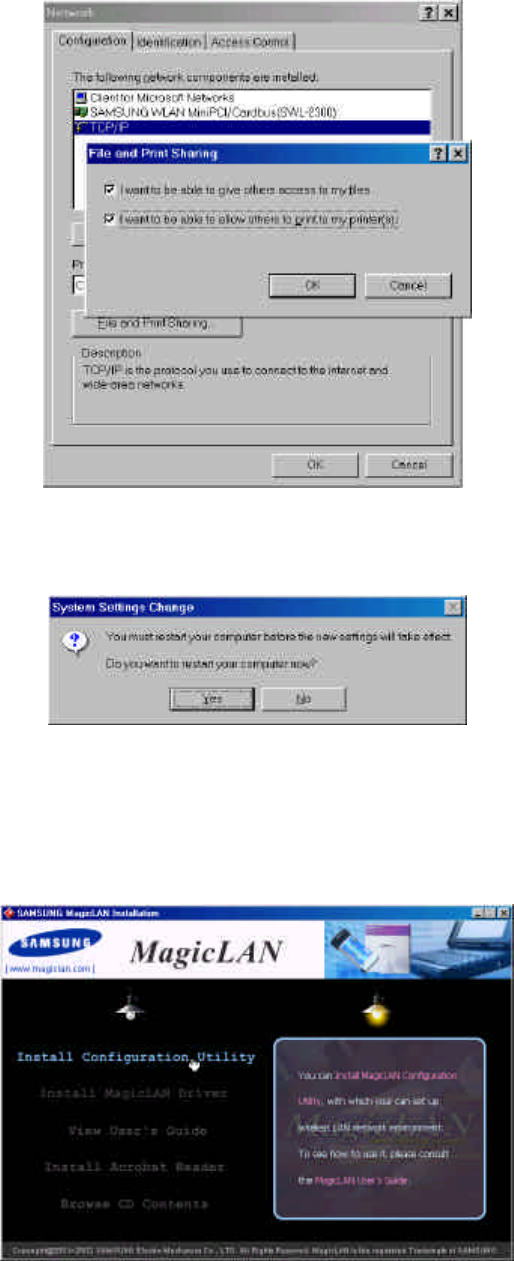
20
computer by other users connected to that network by setting the appropriate options.
13. Screen message ‘Do you want to restart your computer now?’ will pop up.
Select Yes. It will shut down your computer and will restart.
14. After booting the computer, you have to draw out and re-insert the MagicLAN
Installation CD to be automatically installed. You can click ‘Install Configuration
Utility’ to install our utility. Choose the appropriate language when a context box
appeared to choose utility’s language.
15. You can set up Wireless LAN environment by our utility program provided. Refer to
‘Chapter 4’ in this manual.
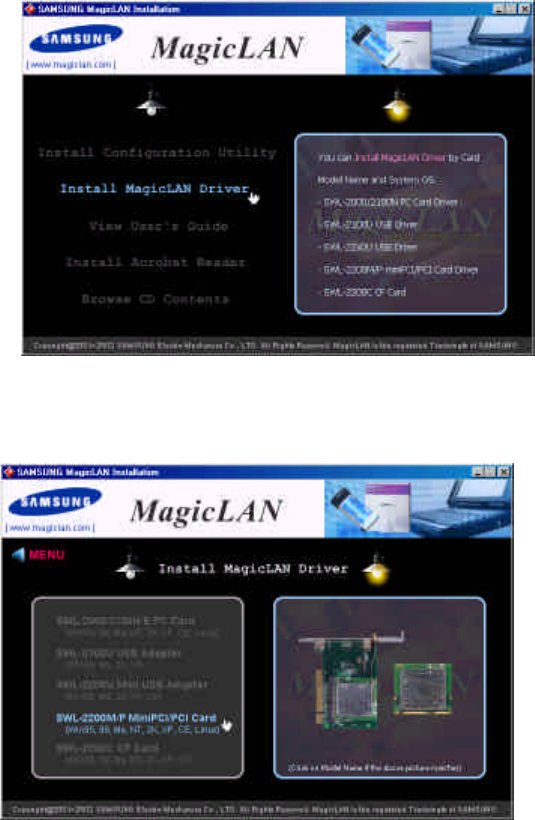
21
< Method 2 – Installing software first >
1. If you insert the MagicLAN Installation CD into the CD-ROM drive, software will launch
automatically. Then, click on the ‘Install MagicLAN Driver’.
2. You can see the pictures of Wireless LAN Cards by model name.(SWL-2300M/N/P
MiniPCI/PCMCIA/PCI Card). Click on the model name to install it’s driver.
3. Click on Operating System in the right screen in which you want to install driver.
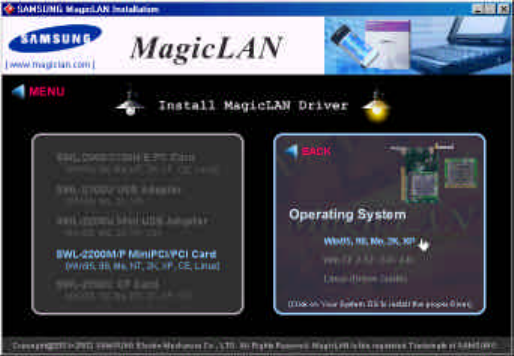
22
3. After installing driver, shut down your computer and insert card. And power on the
computer.
4. The system recognize the Wireless LAN Card.
5. The other procedures are same to 7~15 of < Method 1 - Inserting card
first >
Cf.) The third method :
You can combine ‘Method 1’ with ‘Method 2’. In other words, after inserting card
into the computer, you can install driver and utility by using the installshield instead, not
by the inf file. In case of Windows 2000 and Windows XP, system will recognize the
card automatically during installation .
Notice that if you install a card after removing it in a Device Manager, you have to mark
the check box(“Do you want to scan for hardware changes?”). The function is same to
the “Refresh” in the Device Manager.
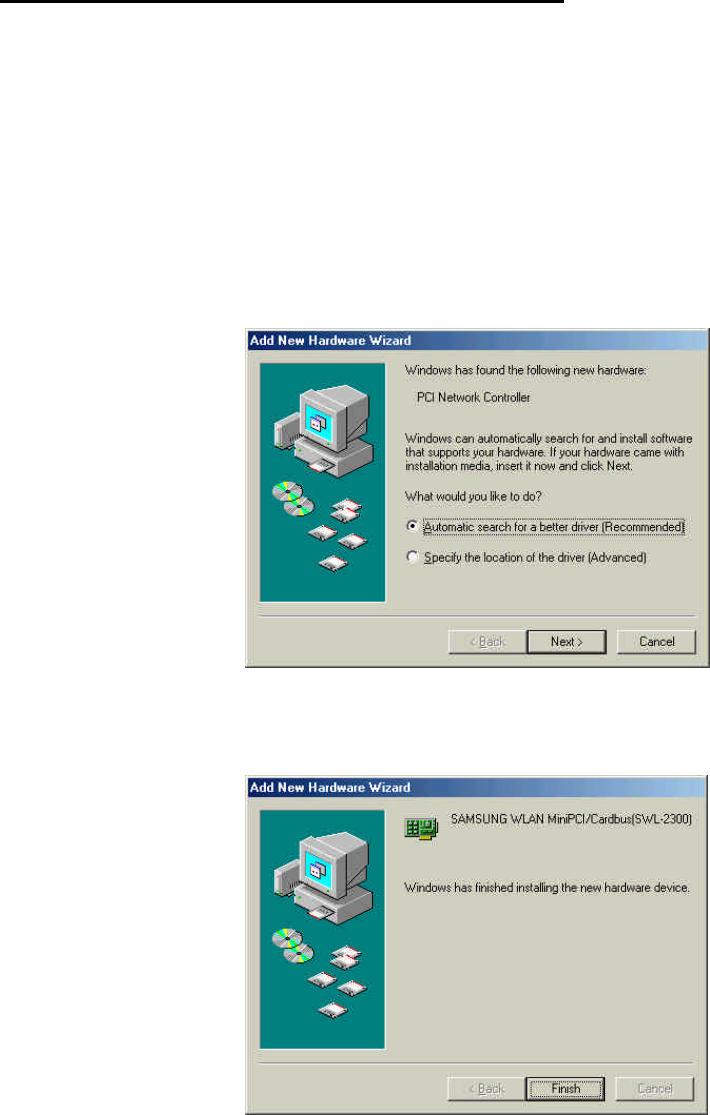
23
3.3 Installation Procedure of Windows ME
Please follow the following steps one by one to install the MiniPCI/PCMCIA/PCI Card
successfully.
< Method 1 - Inserting card first >
1. Insert the MiniPCI/PCMCIA/PCI Card into the slot of your computer.
2. Power on your computer and allow Windows ME to load fully.
3. “Add New Hardware Wizard” is appeared and the system looks for “PCI Network
Controller”. Check if “Search for the best driver for your device(recommended)” is
selected. Insert the MagicLAN Installation CD into the CD-ROM drive.
4. Press ‘NEXT’ and you can find the “SAMSUNG WLAN MiniPCI/Cardbus(SWL-
2300) ” . And the system will copy driver files.
Now driver files are fully installed to start the Wireless LAN Card’s operation. If screen
message ‘Do you want to restart your Computer now?’ will pop up, select Yes.
5. After booting the computer, right click on the My Computer using the mouse and click
property.
6. Check for the SAMSUNG WLAN MiniPCI/Cardbus(SWL-2300) by clicking on the
Device manager. If you find the Yellow sign on the adapter, it shows the installation
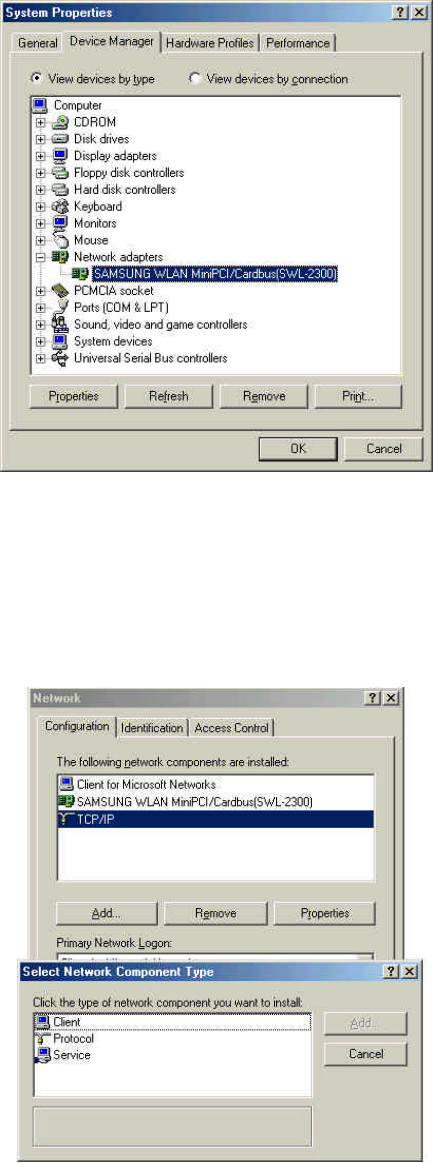
24
is not successful. Select the Adapter and click on Remove. Restart your computer after
uninstalling the driver. (See the Adapter Removal in section 3.7)
7. Right click on the Network Neighborhood using the mouse. Select Properties
from the pop up menu. The network box appears and you see three main tabs:
Configuration, Identification and Access Control.
8. Click on the configuration tab and then click on the add button. Select Network
Component Type box appears. Click on the Protocol then click the Add button.
9. Select Network Protocols box appears. From the list of manufactures, click on Microsoft.
From the list of network protocols list, select IPX/SPX and TCP/IP, then click OK.( If
you want, you can install the NetBEUI protocol.)
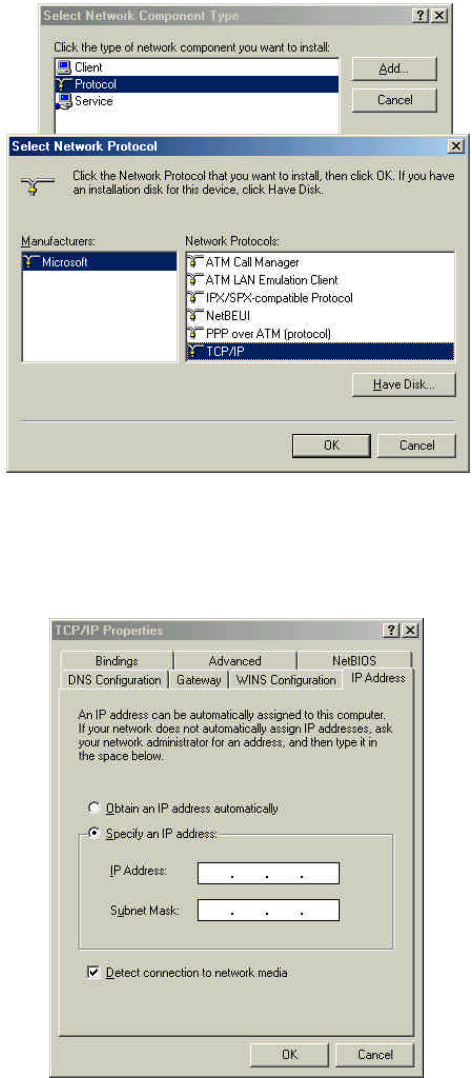
25
10. Select the TCP/IP option for setting the IP address value, gateway value and DNS
value of your computer. After setting these parameters appropriately, click OK to return
to Network Component Type.
11. you can select the File and Printer Sharing options as well as the access to your
computer by other users connected to that network by setting the appropriate options.
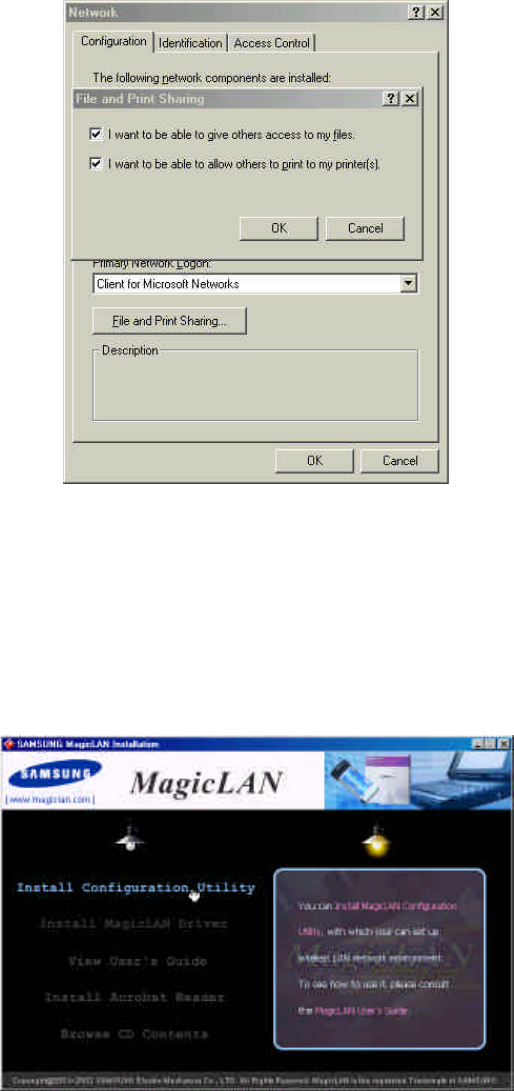
26
12. Screen message ‘Do you want to restart your Computer now?’ will pop up.
Select Yes. It will shut down your computer and will restart.
13. After booting the computer, you have to draw out and re-insert the MagicLAN
Installation CD to be automatically installed. You can click “Install Configuration
Utility” to install our utility. Choose the appropriate language when a context box
appeared to choose utility’s language.
14. You can set up Wireless LAN environment by our utility program provided. Refer to
‘Chapter 4’ in this manual.
< Method 2 – Installing software first >
1. If you insert the MagicLAN Installation CD into the CD-ROM drive, software will launch

27
automatically. Then, click on the ‘Install MagicLAN Driver’.
2. You can see the pictures of Wireless LAN Cards by model name.(SWL-2300M/N/P
MiniPCI/PCMCIA/PCI Card). Click on the model name to install it’s driver.
3. Click on Operating System in the right screen in which you want to install driver.
4. After installing driver, shut down your computer and insert card. And power on the
computer.
28
5. The system recognize the Wireless LAN Card.
6. The other procedures are same to 5~14 of < Method 1 - Inserting card
first >
Cf.) The third method :
You can combine ‘Method 1’ with ‘Method 2’. In other words, after inserting card
into the computer, you can install driver and utility by using the installshield instead, not
by the inf file. In case of Windows 2000 and Windows XP, system will recognize the
card automatically during installation .
Notice that if you install a card after removing it in a Device Manager, you have to mark
the check box(“Do you want to scan for hardware changes?”). The function is same to
the “Refresh” in the Device Manager.
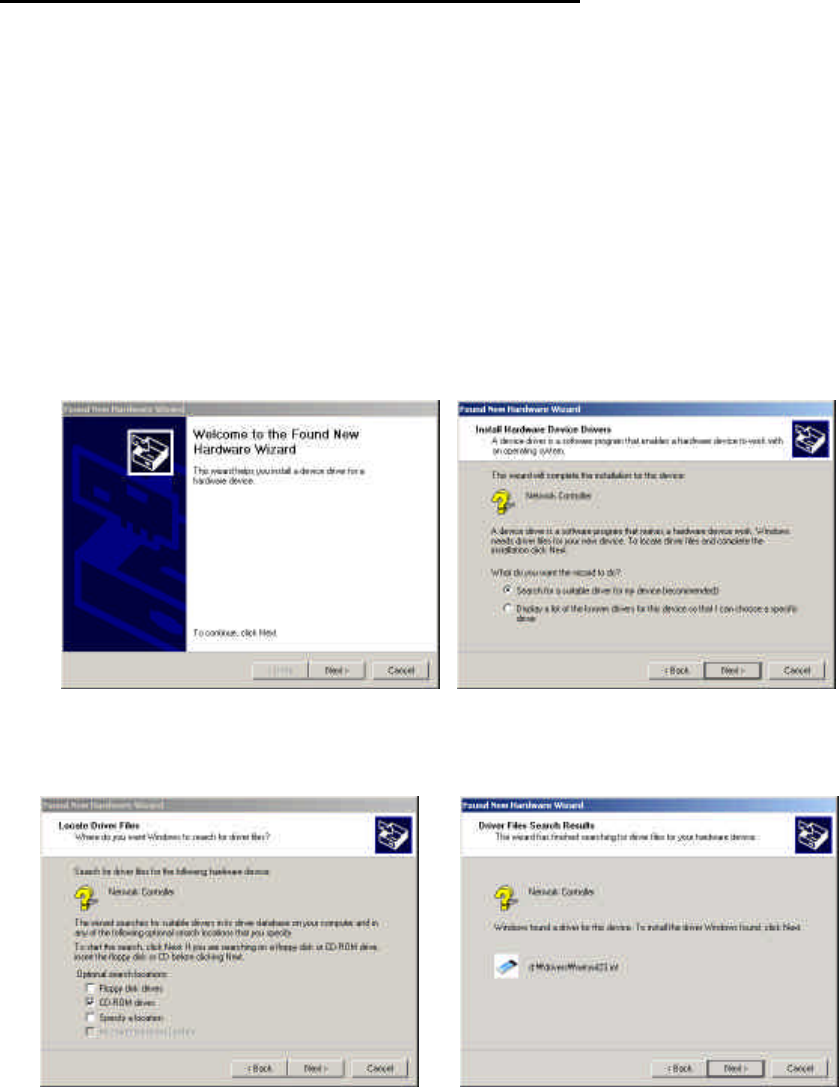
29
3.5 Installation Procedure of Windows 2000
Please follow the following steps one by one to install the MiniPCI/PCMCIA/PCI card
successfully.
< Method 1 - Inserting card first >
1. Insert the MiniPCI/PCMCIA/PCI Card into slot of your computer.
2. Power on your computer and allow Windows 2000 to load fully.
3. Found New Hardware Wizard appeared and the system looks for “Network
Controller”. Press NEXT button and check if “Search for the best driver for your
device(recommended)” is slected and then press NEXT button. Insert the MagicLAN
Installation CD into the CD-ROM drive. You can ignore the MagicLAN Utility’s screen
of the CD-ROM..
4. Mark the “CD-ROM Drive” tap and then press ‘NEXT’. You can find the INF file and
now it is ready to install our software.
5. Press NEXT and system will copy driver files. Now driver files are fully installed to start the
Wireless LAN Card’s operation.
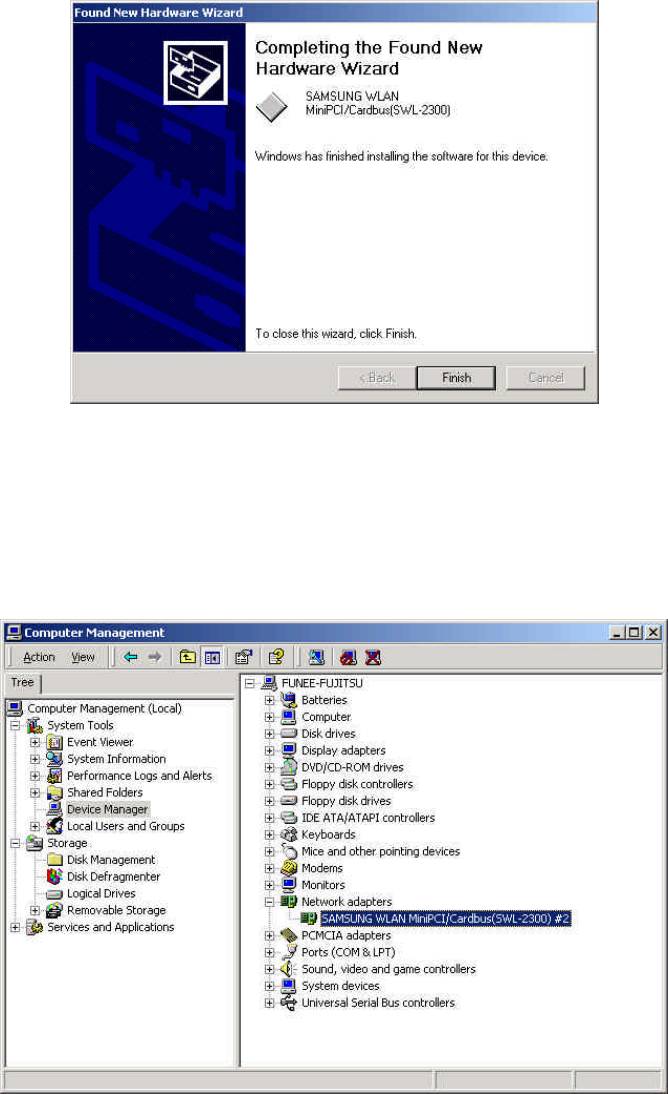
30
6. Check for the SAMSUNG WLAN MiniPCI/Cardbus(SWL-2300) on the Device
Manger of a Computer Management in the Administrative Tools . If you find the Yellow sign
on the adapter, it shows the installation is not successful. In this case, select the adapter and click
on Remove. Restart your computer after uninstalling the driver to make the changes effective.
(See the Adapter Removal in section 3.7)
7. Right click on the Network Places using the mouse and double-click on the Local Area
Connection ,and then click on Properties.
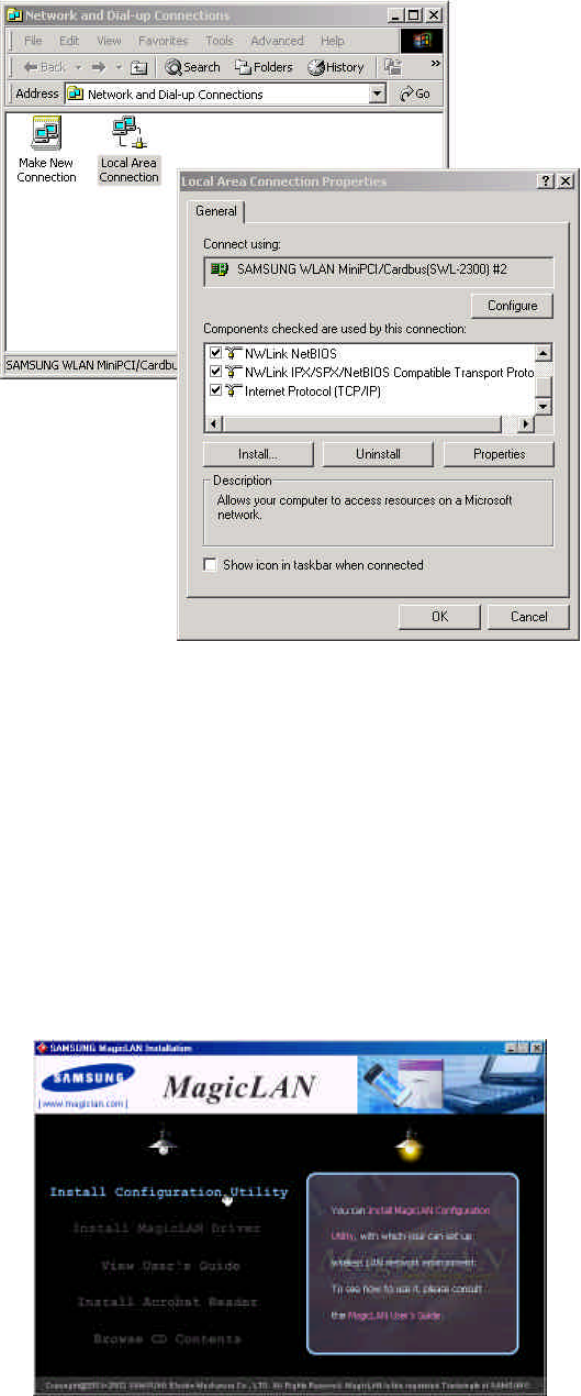
31
8. Click on the TCP/IP option for setting the IP address for your computer. Set the IP
value, Gateway value, DNS value. After setting these parameters appropriately, click
OK to return to Network Component Type.
9. You can select the File and Printer Sharing for Microsoft Networks options to allow
the Access to your computer by other users connected to that network by setting the
computer sharing options. Click on OK.
10. After booting the computer, you have to draw out and re-insert the MagicLAN
Installation CD to be automatically installed. You can click Install Configuration Utility
to install our utility. Choose the appropriate language when a context box appeared to
choose utility’s language.
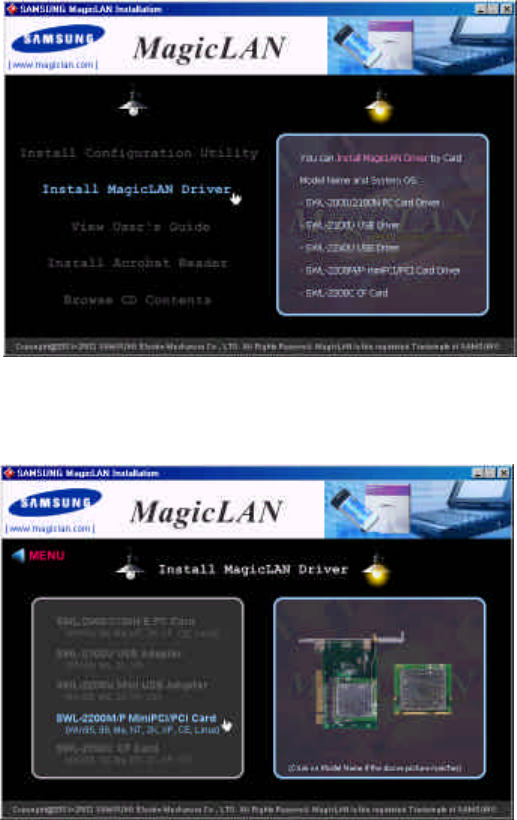
32
11. You should reboot the computer to use our utility properly in the NT-based
OSs(Windows NT4.0, 2000, XP).
12. After rebooting your computer, you can set up Wireless LAN environment by our utility
program provided. Refer to ‘Chapter 4’ in this manual.
< Method 2 – Installing software first >
1. If you insert the MagicLAN Installation CD into the CD-ROM drive, software will launch
automatically. Then, click on the ‘Install MagicLAN Driver’.
2. You can see the pictures of Wireless LAN Cards by model name.(SWL-2300M/N/P
MiniPCI/PCMCIA/PCI Card). Click on the model name to install it’s driver.
3. Click on Operating System in the right screen in which you want to install driver.
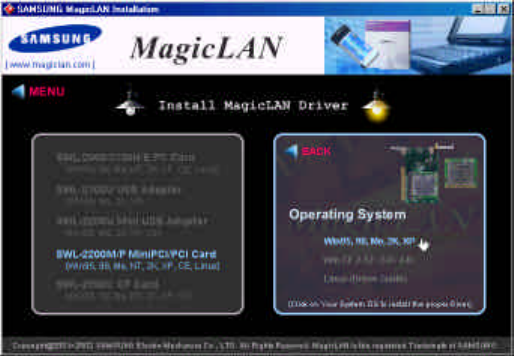
33
4. After installing driver, shut down your computer and insert Wireless LAN card. And
power on the computer.
5. The system recognize the Wireless LAN Card.
6. The other procedures are same to 6~12 of < Method 1 - Inserting card first
>
Cf.) The third method :
You can combine ‘Method 1’ with ‘Method 2’. In other words, after inserting card
into the computer, you can install driver and utility by using the installshield instead, not
by the inf file. In case of Windows 2000 and Windows XP, system will recognize the
card automatically during installation .
Notice that if you install a card after removing it in a Device Manager, you have to mark the check
box(“Do you want to scan for hardware changes?”). The function is same to the “Refresh” in the
Device Manager.
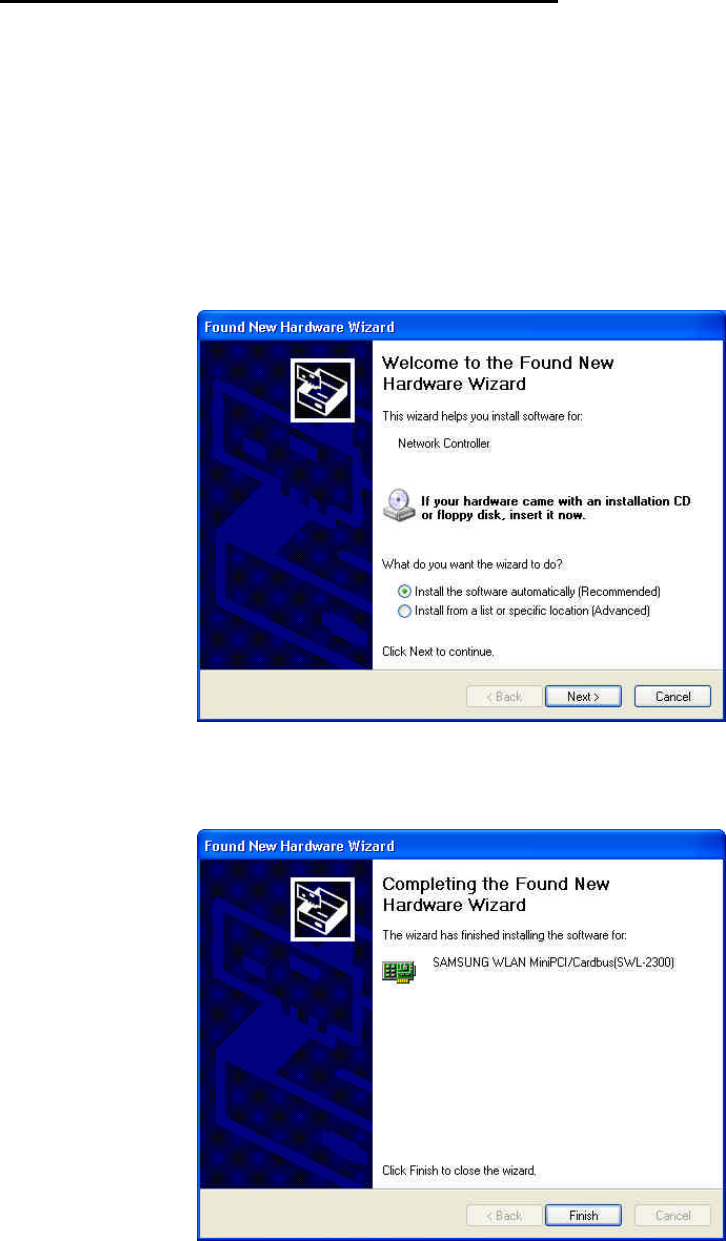
34
3.6 Installation Procedure of Windows XP
Please follow the following steps one by one in order to install the MiniPCI/PCMCIA/PCI Card
successfully.
< Method 1 - Inserting card first >
1. Insert the MiniPCI/PCMCIA/PCI Card into slot of your computer.
2. Power on your computer and allow Windows XP to load fully.
3. “Found New Hardware Wizard” appeared and the system looks for “Network
Controller”. Insert the MagicLAN Installation CD into the CD-ROM Drive.
4. You can find the “SAMSUNG WLAN MiniPCI/Cardbus(SWL-2300)” and system will
copy driver files.
5. Now driver files are fully installed to start the Wireless LAN Card’s operation.
6. Check for the SAMSUNG WLAN MiniPCI/PCI Cardbus(SWL-2300) on Computer
Management in the Administrative Tools of the Control Panel. If you find the
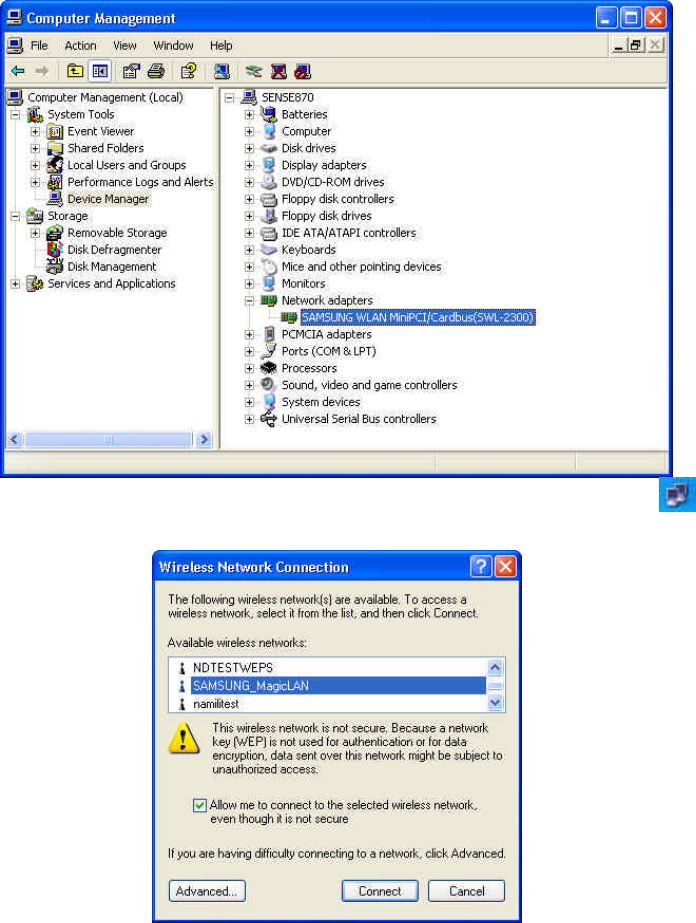
35
Yellow sign on the adapter, it shows the installation is not successful. In this case, select
the adapter and click on Remove. Restart your computer after uninstalling the driver to
make the changes effective. (See the Adapter Removal in section 3.7)
7. Of the icons displayed on the right bottom of desktop, click on icon stated
Wireless Network Connection.
8. When you are using DHCP, just select the AP that you want to connect in the Connect
to Wireless Network above.
9. To manually set your IP address, WEP and some other configuration, click on
Advanced of the above picutre and then click Configure Available networks on the
Wireless Networks Tab . Set the SSID and parameters to be needed to modify and
then clicking on OK. The AP that you selected will be displayed on the Prefered
Networks.
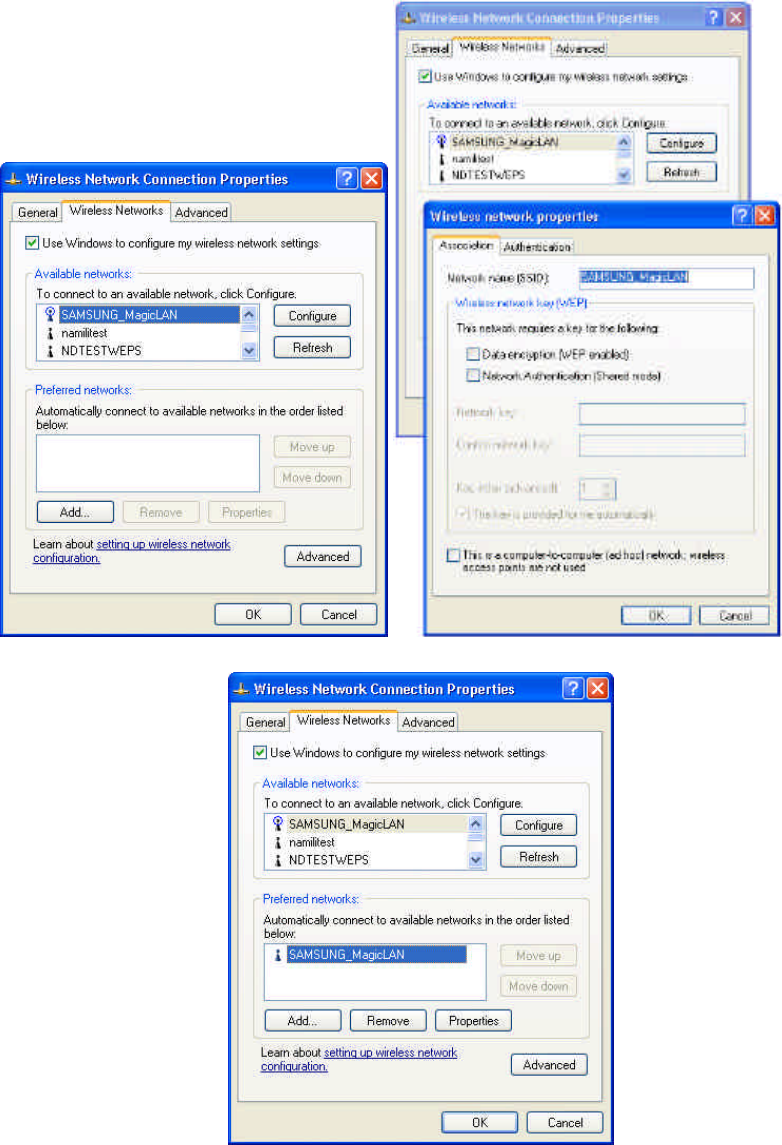
36
10. Next, move to the General Tab. After the double click the “Internet
Protocol(TCP/IP)”, set the IP value, Gateway value and DNS value and click on
OK. All will be done by clicking on OK once more.
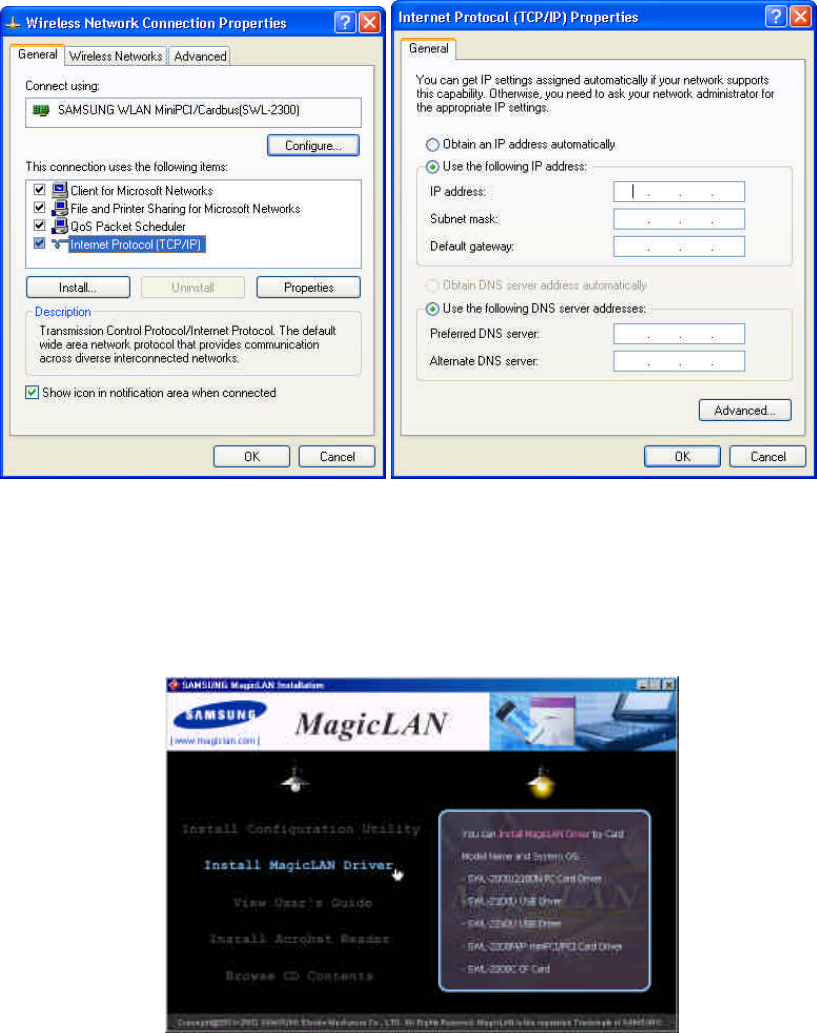
37
< Method 2 – Installing software first >
1. If you insert the MagicLAN Installation CD into the CD-ROM drive, software will launch
automatically. Then, click on the ‘Install MagicLAN Driver’.
2. You can see the pictures of Wireless LAN Cards by model name.(SWL-2300M/N/P
MiniPCI/PCMCIA/PCI Card). Click on the model name to install it’s driver.
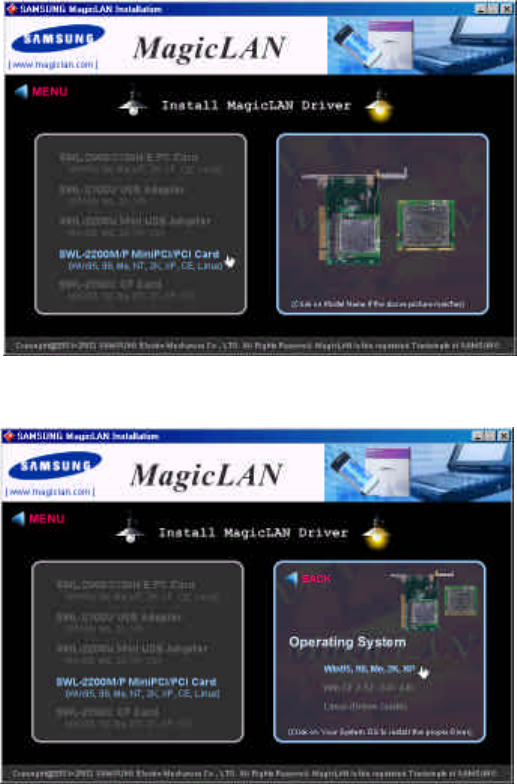
38
3. Click on Operating System in the right screen in which you want to install driver.
4. After installing driver, shut down your computer and insert Wireless LAN card. And power
on the computer.
5. The system recognize the Wireless LAN Card. If Found New Hardware Wizard
appears, just click Next .
6.The other procedures are same to 6~10 of < Method 1 - Inserting card first
>
Cf.) The third method :
You can combine ‘Method 1’ with ‘Method 2’. In other words, after inserting card
into the computer, you can install driver and utility by using the installshield instead, not
by the inf file. In case of Windows 2000 and Windows XP, system will recognize the
card automatically during installation .
Notice that if you install a card after removing it in a Device Manager, you have to mark the check
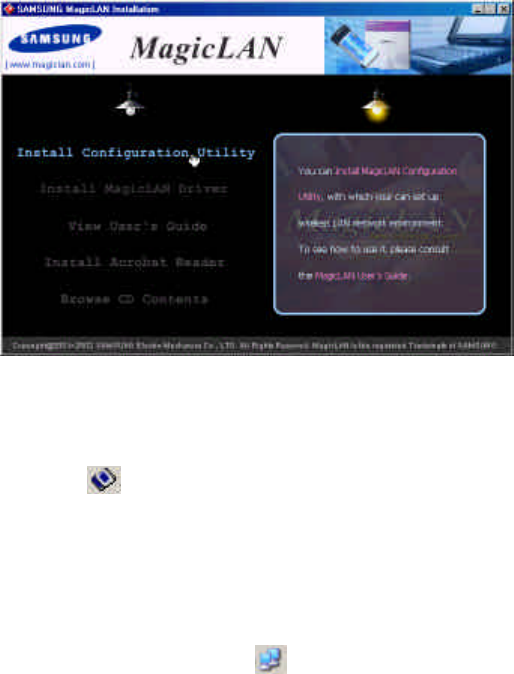
39
box(“Do you want to scan for hardware changes?”). The function is same to the “Refresh” in the
Device Manager.
[ Use of Our company’s Utility in Windows XP ]
You can also set up the Wireless LAN by the our company’s utility program instead of Windows
XP’ utility program.
After booting the computer, you have to draw out and re-insert the MagicLAN Installation CD
to be automatically installed. You can click “Install Configuration Utility” to install our utility.
Choose the appropriate language when a context box appeared to choose utility’s language.
You should reboot the computer to use our utility properly in the NT-based OSs(Win NT, Win
2000, Win XP).
- If you click the icon on the right bottom of the desktop, you can see the current
state of the Wireless LAN.
- Click on Option of the General settings on the bottom of the Utility and mark
“Manage the Wireless Control by this utility under WinXP”. For more details,
refer to ‘Chapter 4’ in this manual.
- If you want to use Wireless LAN Utility in the system of Windows XP , be sure that
the mark of “Manage the Wireless Control by this utility under WinXP” of the
our company’s utility program is removed.
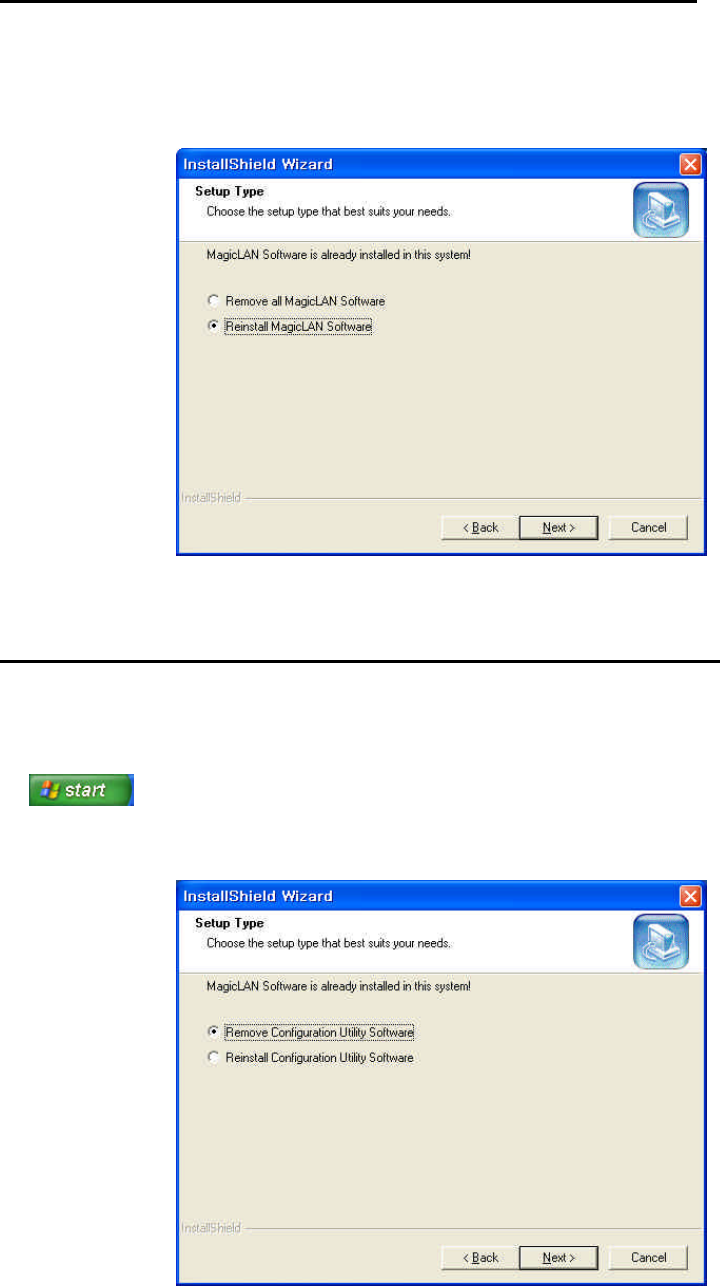
40
3.6 Update of MagicLAN Wireless LAN Card Driver
1. After inserting the MagicLAN Installation CD, click the Install MagicLAN Driver and
select the Card and Operating System that you want to update in.
2. If selection box appears, select ‘Reinstall MagicLAN Software’ between ‘Remove’ and
‘Reinstall’.
3.7 Removal of MagicLAN Wireless LAN Card Driver
(Adapter Removal)
Click like followings :
-> All Programs -> MagicLAN -> MagicLAN Driver -> Remove
MiniPCI Card adapter.
Select ‘Remove all MagicLAN Software’ and click Next.
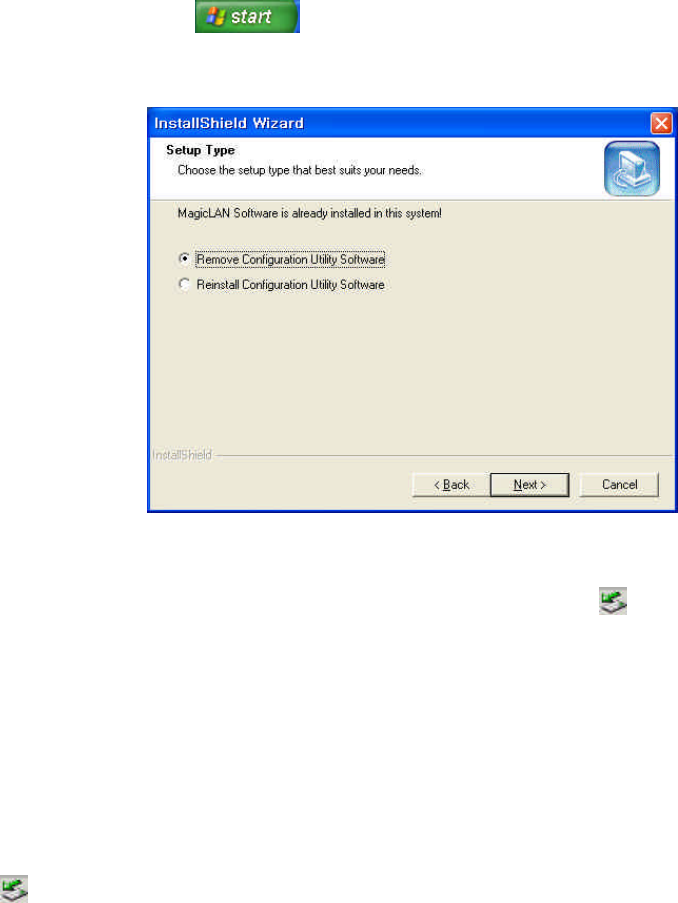
41
(Utility Removal)
Click like followings : -> All Programs -> MagicLAN -> MagicLAN
Utility -> Remove Utility Uninstall.
Select ‘Remove Configuration Utility Software’ and click Next .
(cf) If you want to just remove the WLAN Card from the PC, click and Stop SAMSUNG
WLAN MiniPCI/Cardbus(SWL-2300) Card icon the right bottom of your computer screen.
Then you remove the WLAN Card after clicking the OK button on the message, ‘SAMSUNG
WLAN MiniPCI/Cardbus(SWL-2300) Card can now be safely removed from the system’
(Notice that you should power off your computer and remove your card in case of MiniPCI/ PCI
card)
** - Safely remove hardware icon (Windows ME , 2000, XP)
In the case of Windows NT4.0, right click on the Network Neighborhood using the mouse and
eliminate the ‘SAMSUNG WLAN MiniPCI/Cardbus(SWL-2300)’ on the Network
Component.
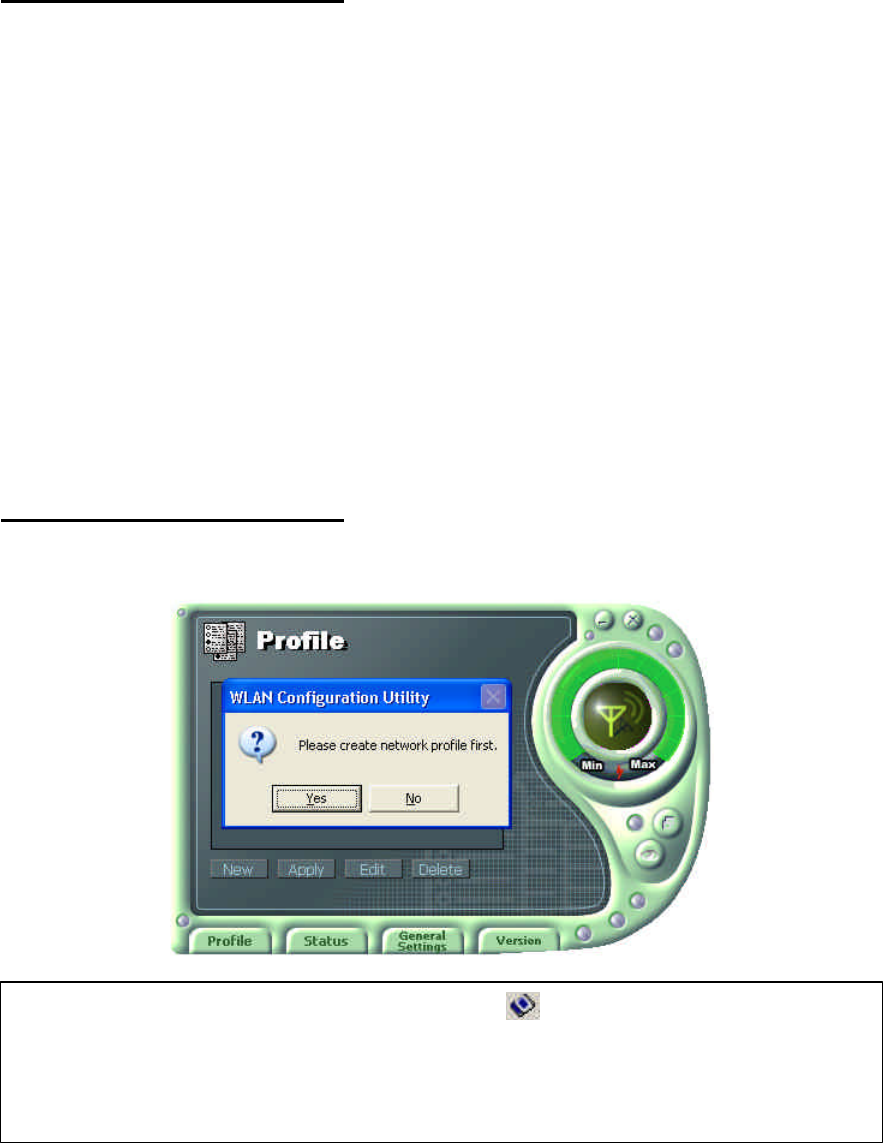
42
4. The Program For Setting MagicLAN
4.1 The concept of Profile
- TCP/IP settings for the fixed networks/Wired LAN have no problems, as they do not
deal with the mobility. But in case of mobile equipments such as WLAN card, when
WLAN client has moved from home to Office or vice-versa, the difficulty for using the
old TCP/IP settings arises.
- The concept of profile makes it easy to use the same TCP/IP settings for WLAN cards
regardless of the movement.
- Profile can be selected again with ease if it were saved. Saving the settings for WLAN
and TCP/IP as a Profile, it is easy for user to select and use one of the saved profiles,
especially it can be used quickly without rebooting your computer while the settings for
TCP/IP is updated.
4.2 Installation Procedure
First time use of WLAN on your computer needs the following settings.
1. Insert your WLAN card. After clicking on the icon , which
is found at the right bottom
your computer screen, “Please create your first network profile now”
window will appear. Click
‘Y’ button for yes and the following window
will appear. cf) The above message will not be
appeared in the Win XP. Make a Profile with clicking ‘New’ button.
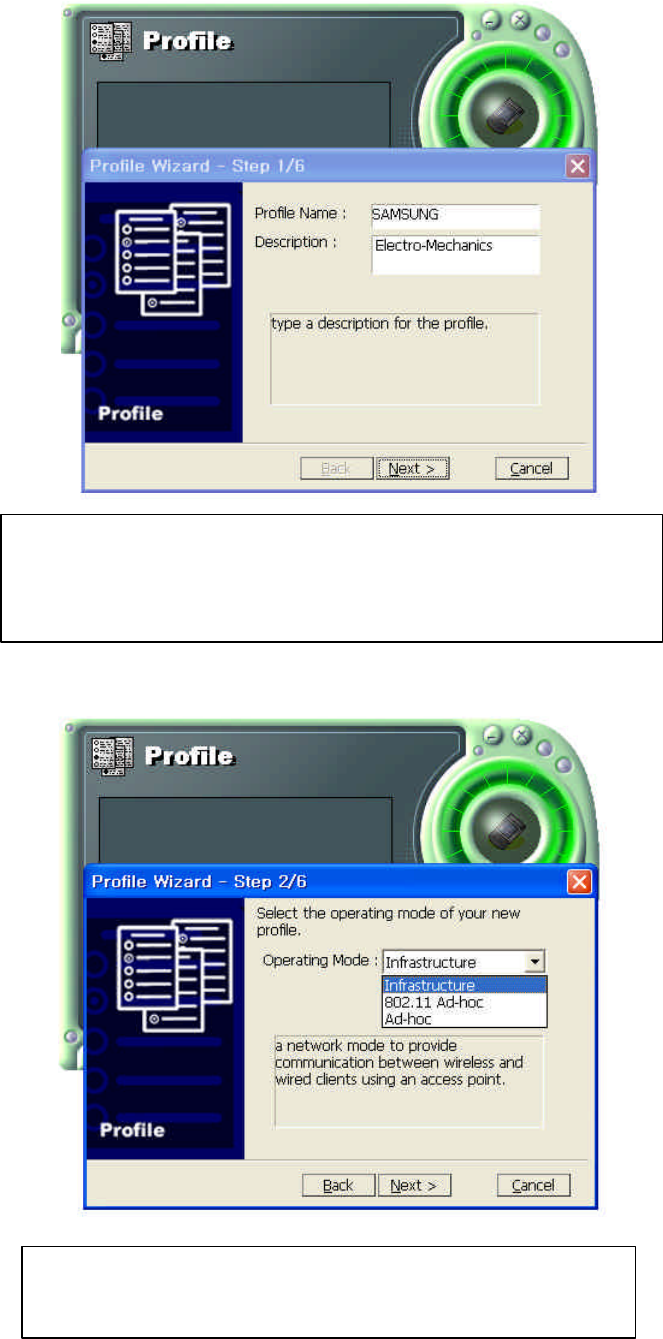
43
2. Input a profile name in Profile Name and description for your profile
name in Description and click the NEXT button, the follo
wing window
will appear.
3.
Select the Operating Mode to use and click the NEXT button.
Default operating mode is Infrastructure.
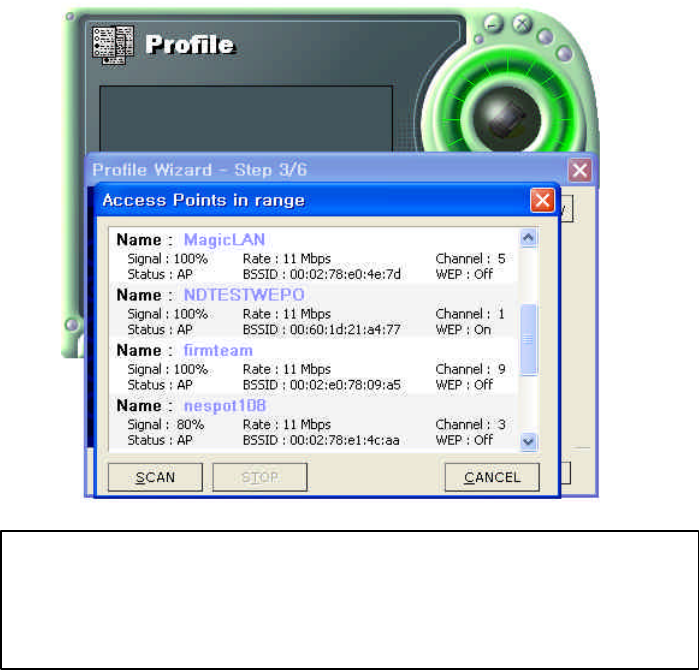
44
- Infrastructure Network is the structure that the communication between Wired LAN and
Wireless LAN is feasible. Wireless client is possible to access to the other Network (include
Internet) via Access Point.
- Ad-hoc/802.11Ad-hoc Network support the communication among Wireless clients. Due to the
support of communication among Wireless equipment, Ad-hoc Network doesn’t need Access
Point. (cf. 802.11 ad-hoc is satisfied with the 802.11 specification)
4. If you clicked on the Survey, the above window will appear showing
you
Access Points or Stations (Ad hoc) that are able to connect now.
Select the AP that has the highest signal to use as an SSID.
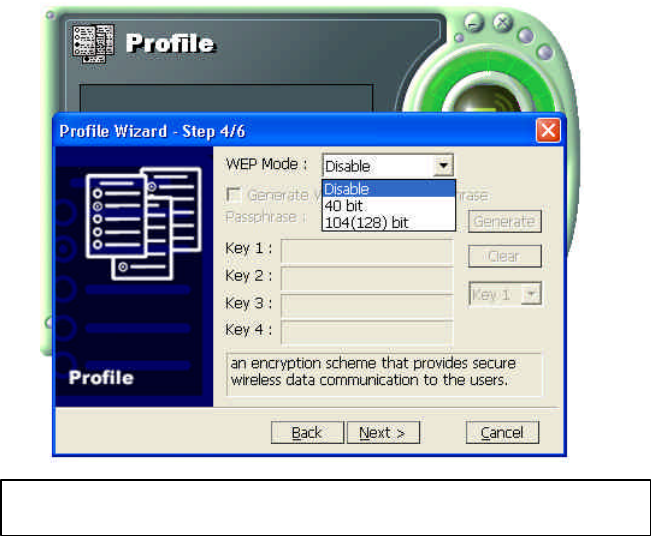
45
- WEP Mode
l This is security tool to protect your DATA from unauthorized users.
l To use the function of WEP, The WEP key settings for client must be same to that of AP
in the Infrastructure Mode, and the WEP key settings must be same for all clients in the
Ad-hoc/802.11Ad-hoc Mode.
5. Select the WEP Mode and Click the Next button.
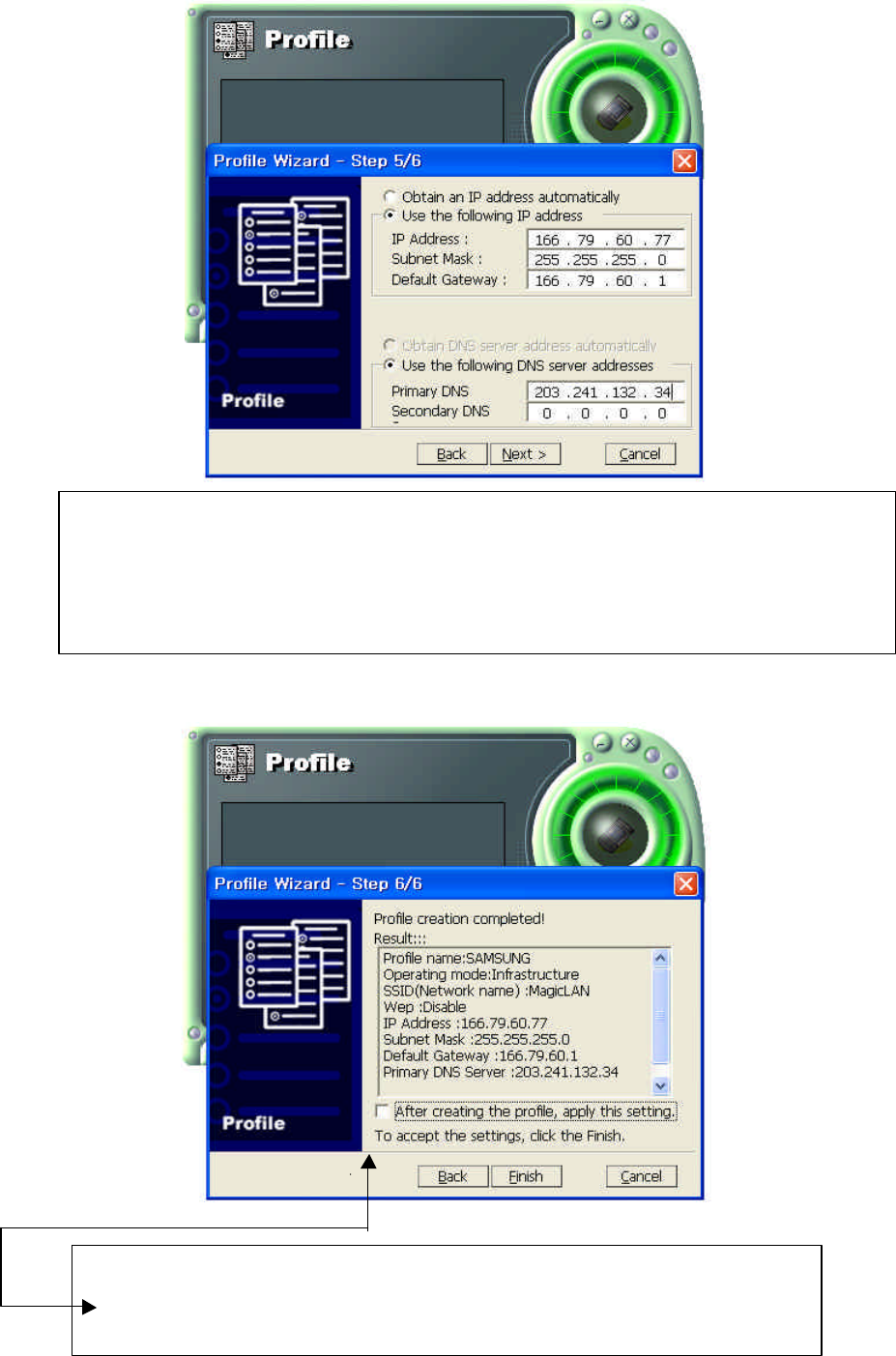
46
6. Enter a valid IP address. IP address can be allocated automatically. (cf. it
is limited to users
who use the DHCP server or ADSL connection). As only checked in “
Manage TCP/IP
together with Profile”, IP address can be controlled
in the Profile. This menu does not appear
under MS Windows NT. Click NEXT to see the following window.
7. Showing you the settings selected so far. Click the Finish button.
Check on this box. It will work on the system after clicking the Finish button.
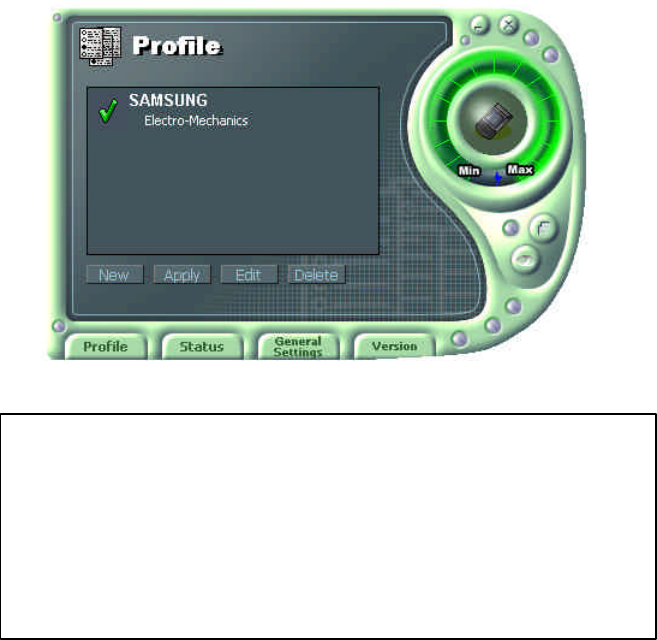
47
8. Cli
ck the Profile name shown in the above window click the Apply
button. The settings will be over. If the IP address entered in the
system settings is different than the IP address selected under
profile name, system IP settings will be changed without reboo
ting
your system.
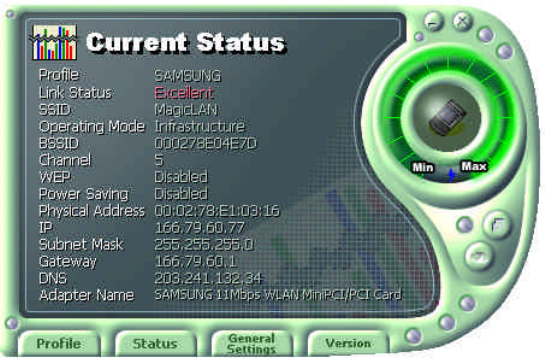
48
5. The main configuration of Program
During the installation of your SAMSUNG WLAN Card, configuration utility is also installed. You
can see the icon at the right bottom of your screen. Double clicking that icon will show you the
screen as shown below.
The following describes the meanings of variables shown in the WLAN configuration.
l Profile: The arbitrary designation by user. It is the profile name to distinguish each Profile.
So when you set the Profile, you would better choose the name that can send the
contents it has.
l Link Status: you Link Status shows a client connection state with AP (In Infrastructure
mode) or with other clients (In 802.11Ad-hoc Mode).
l SSID: It represents the name of a group consisting of WLAN users only. It is also called
ESSID.
l Operating Mode: There are three Modes. Infrastructure Mode (the connection among
clients through an AP), 802.11Ad-hoc/Ad-hoc Mode (direct connection among clients)
l BSSID: It shows the Physical Address of WLAN card inserted in AP in the
Infrastructure Mode and the Random Generation value in the 802.11 Ad-hoc Mode.
l Channel: It shows channel number in use for communication between AP and client or
among clients. When the Network Mode is set to the Infrastructure or 802.11Ad-
hoc/Ad-hoc Modes, it searches a channel automatically.
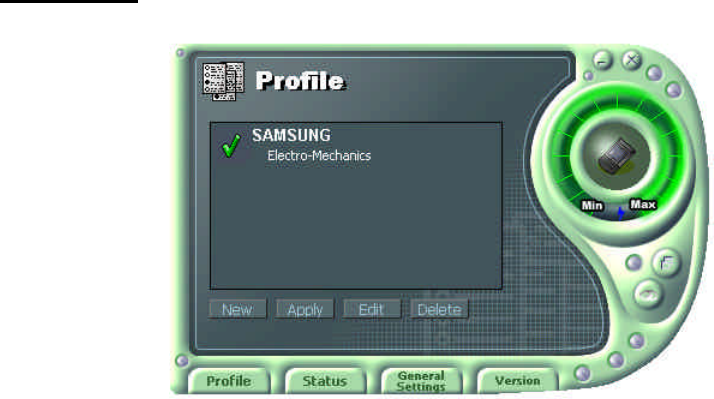
49
l WEP: Security tool to be used for encryption/decryption of data to be exchanged
between clients or between clients and AP. It denies the authorized access to network if
WEP is enabled.
l Power Saving: The Power Saving Mode that prolongs the life of battery.
l Physical Address: It is the Physical address of WLAN card being used by user. This is
also the MAC address of the WLAN card.
l IP Address: Address used to send data from one computer to another to create the
network of several computers. IP address is unique for every network card installed on a
computer to identify it from other computers.
l Subnet Mask: It is an address that enables along with an IP Address to share a
network Address within the LAN of company.
l Gateway: The network point playing a role as a gateway to enter the other network.
l DNS: It is the system that transforms the name of an Internet domain to the
corresponding IP Address. IP Address is actually needed to locate a computer/server on
the Internet.
l Adapter Name: It shows the kind of WLAN card that the user is using now.
The following description is the fundamental installation of WLAN Card.
5.1 Profile
You can modify your wireless environment four buttons on the bottom of Utility.
5.1.1 The ‘New’ button
Clicking the New button, you can add or make a new Profile.
(Refer to ‘The Program For Setting MagicLAN’ in the Chapter 4)
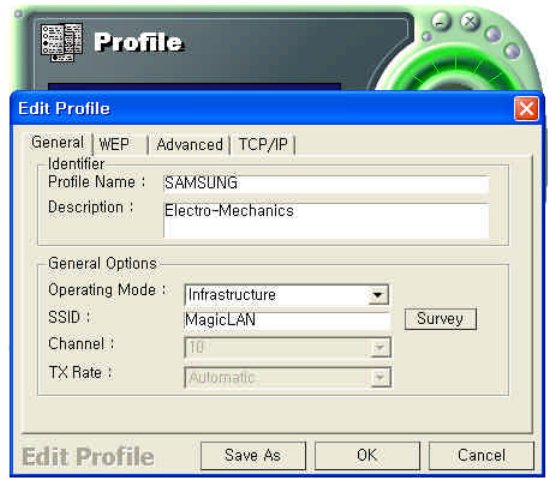
50
5.1.2 The ‘Apply’ button
Select and click a Profile to be used, then the saved or modified profile settings will be used for
configuring your WLAN card.
5.1.3 The ‘Edit’ button
Clicking the Edit button or the Profile name that was created previously, you can modify that
Profile.
- Click the WEP button to set the security.
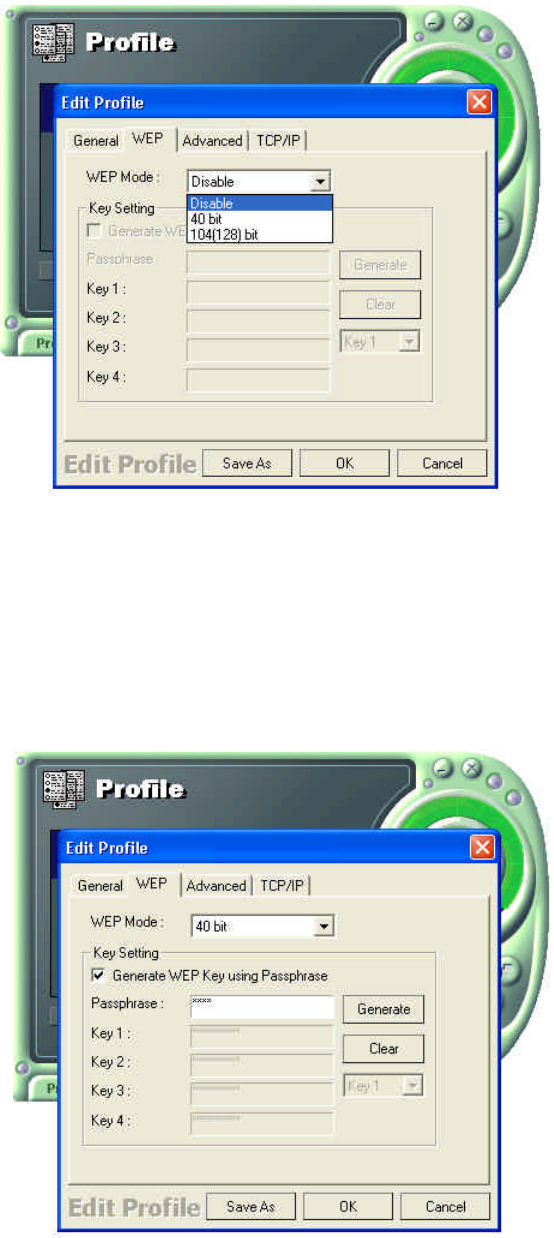
51
1. First of all, select the ‘40 bit’.
2. Input a certain value (ex. test1 etc) in the ‘Passphrase’ and click the Generate button. Then it
will make four values of keys automatically.
3. Then you set the same value to the WEP of AP. (cf. If you use the WLAN made from
other company, you must set the same values in the four keys)
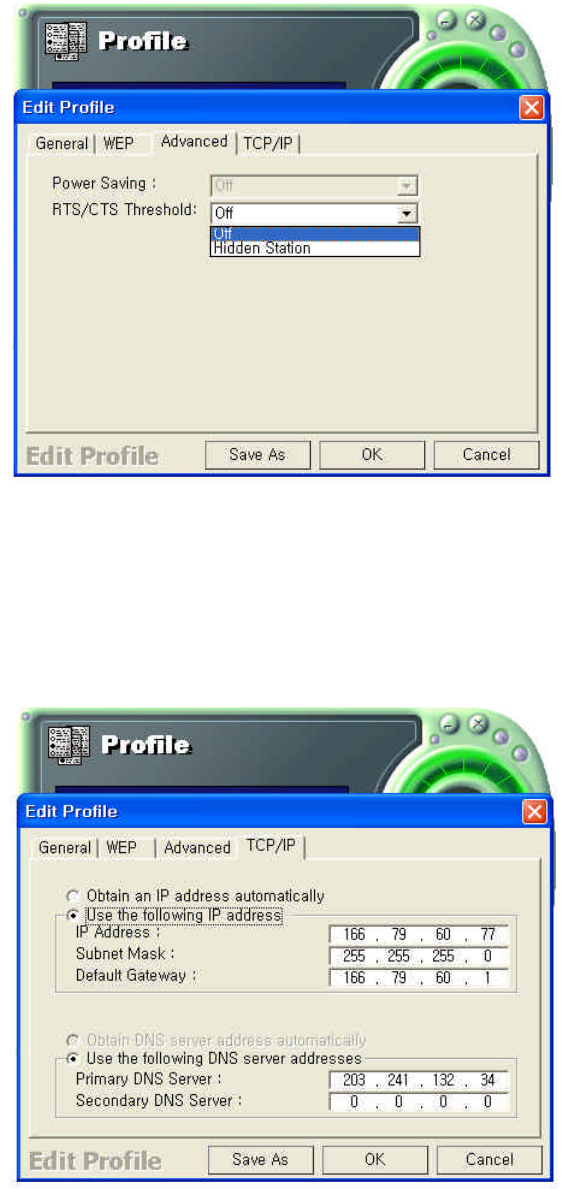
52
- You can set the ‘Power Saving’ and ‘Threshold’ with clicking the Advanced button.
1. Power Saving Mode saves the Battery. (cf.. it can give a lowing of efficiency
according to 802.11Specification)
2. RTS/CTS Threshold Mode is better used in the place surrounded with much RF
interference.
- Click the TCP/IP to input the IP directly or receive IP automatically.
5.1.4 The ‘Delete’ button
Select a profile and click on Delete button to remove that profile.
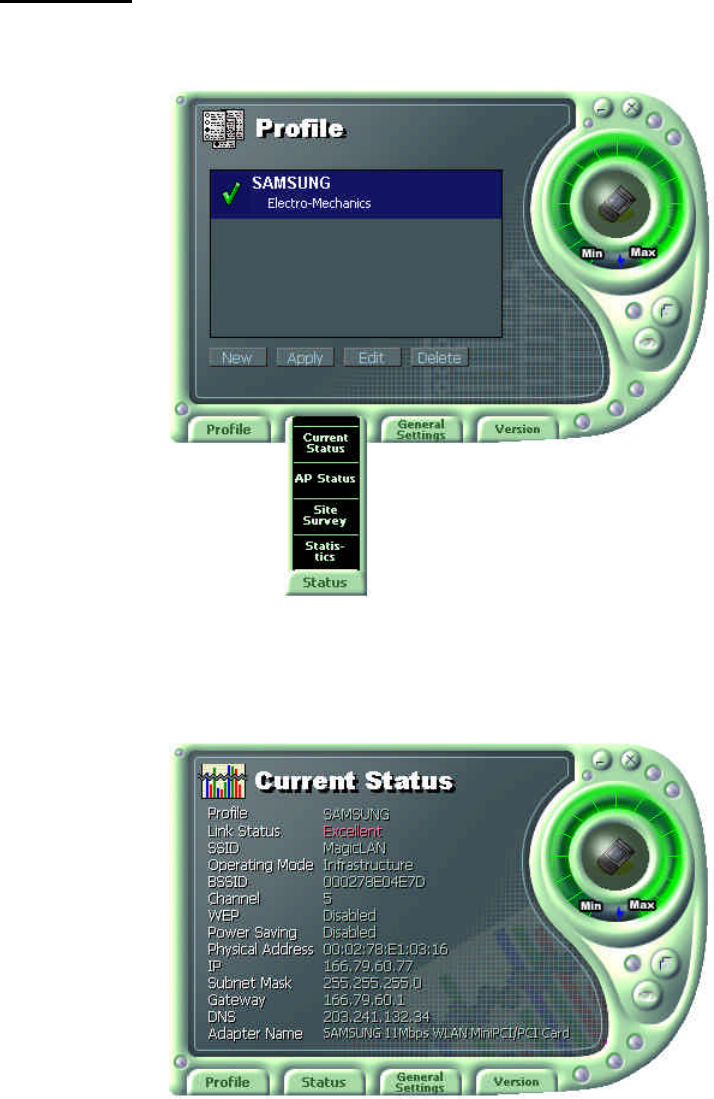
53
5.2 Status
5.2.1 The ‘Current Status’ button
It shows the current state of the WLAN card. (Refer to the ‘ The main configuration of Program’)
5.2.2 The ‘AP Status’ button
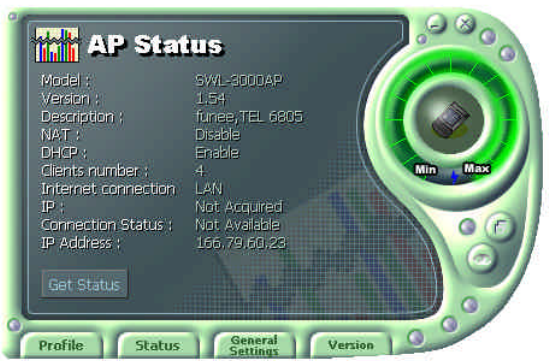
54
It shows the current state of AP. (You can see the IP address changed by the Get Status button)
l Model: It shows the name of model.
l Version: It shows the version of AP.
l Description: It is the name of AP designated by AP manager during AP setup.
l NAT: It shows whether the private IP address (NAT server) is enabled or not.
l DHCP: It shows whether the DHCP sever is enabled or not.
l Clients number: It shows the number of users currently connected with the AP.
l Internet connection: It is the connection type with outer network (LAN, ADSL, ISDN
etc.).
l IP Address: It shows whether the IP address is from DHCP server or NAT server.
l Connected Status: In case the connection type with the outside network is of
ADSL/CABLE type, it shows the connection state between AP and ASP service.
l IP: It is the IP address of the AP.
5.2.3 The ‘Site Survey’ button
It finds you the AP/Station that are connected currently. (It takes a few seconds to be done)
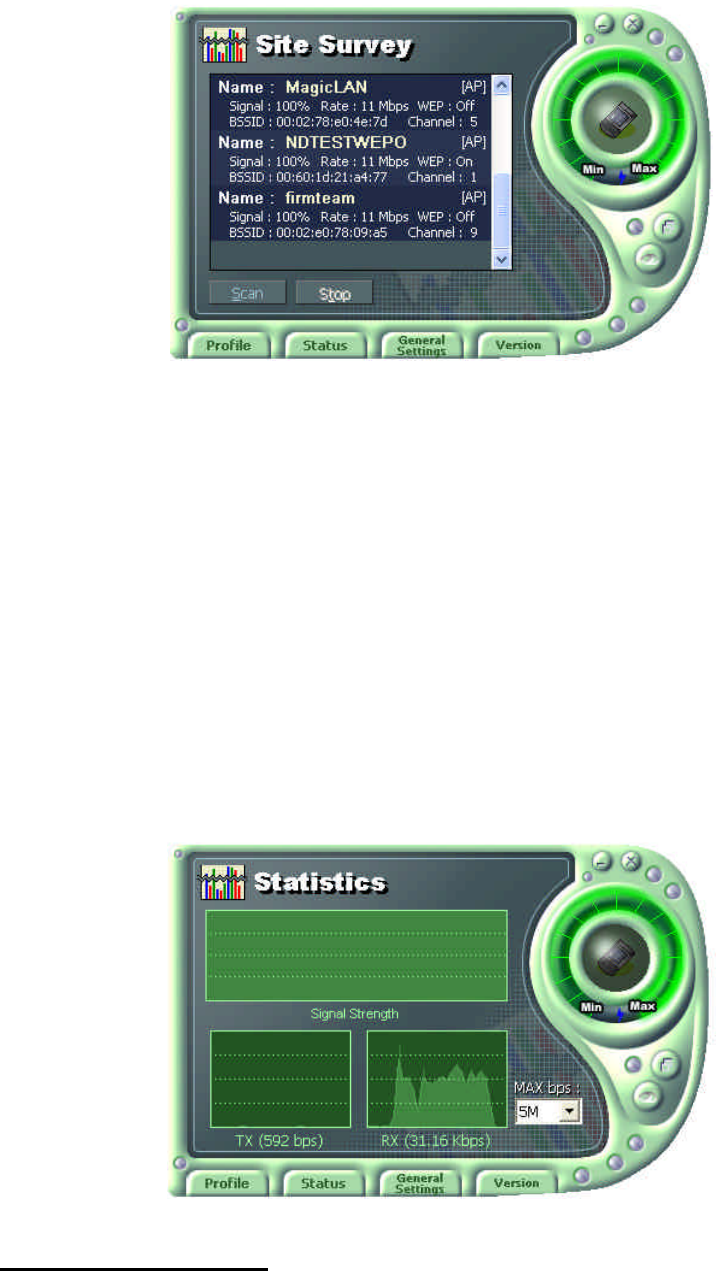
55
l Signal: It shows the connection state of Stations with AP or Master Station.
l Rate: It shows the Tx Data rates.
l WEP: It shows security state with the AP.
l BSSID: It represents the Physical Address of AP in the Infrastructure Mode and the
Random Generation value in the 802.11 Ad-hoc Mode.
l Channel: It shows the currently used channel number.
5.2.4 Statistics
It shows the state of the data transmission. (You can regulate the graph to be see clearly with the
settings of the MAX bps on the right side of bottom)
5.3 General Settings
5.3.1 The ‘DHCP’ button
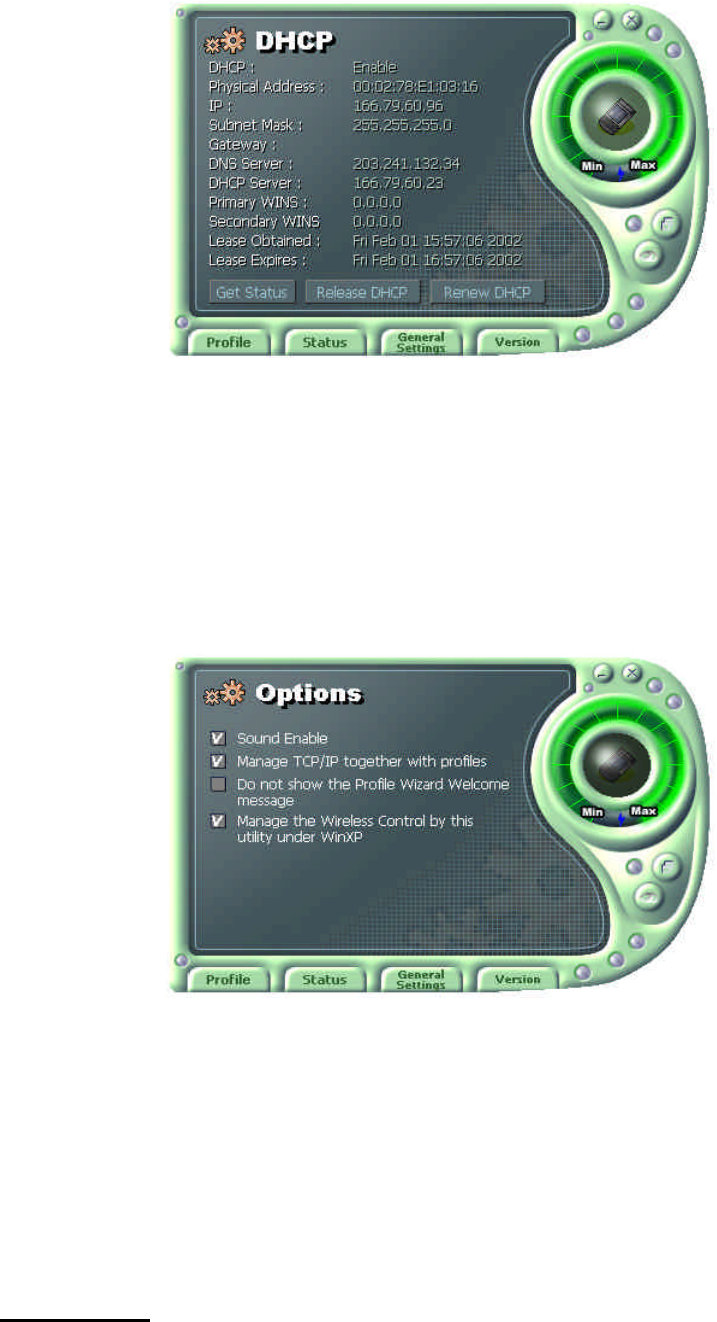
56
- It works when it is enabled.
- The Get Status button shows the updated information obtained from the DHCP server.
- The Release DHCP button releases the IP Address that was received from the DHCP server.
- The Renew DHCP button is for receiving the IP Address from the DHCP server.
5.3.2 The ‘Options’ button
- If you disable the check from the ‘Sound Enable’, you cannot hear the sound whenever you
click.
- If you disable check from the ‘Manage TCP/IP together with profiles’, you cannot control
TCP/IP in the utility. You can just modify TCP/IP in the Network Neighborhood.
- If you check the ‘Do not show the Profile Wizard Welcome message’, ‘Welcome message does
not pop up in case of set or add the Profile.
5.4 Version
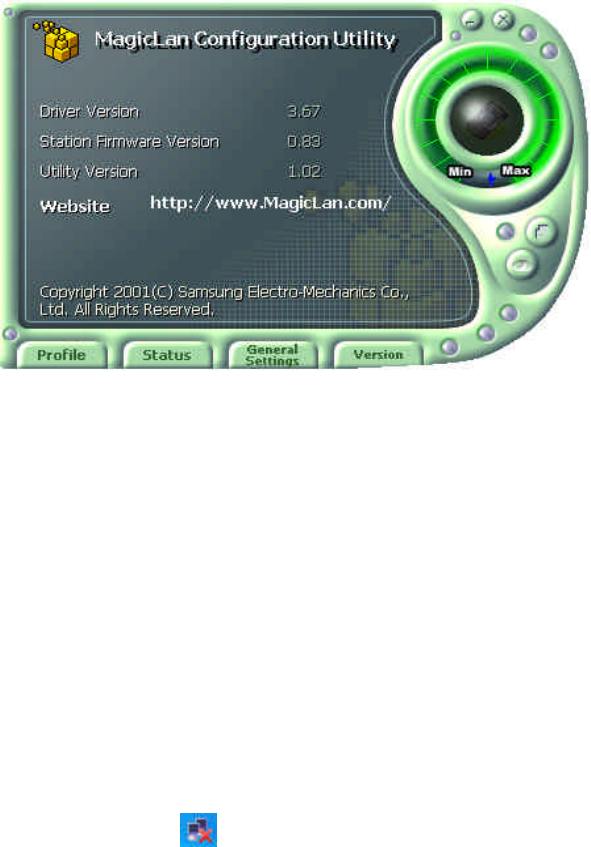
57
- You can see the Driver and Firmware version for your WLAN card currently in use.
- Click the Website to get more information about WLAN.
6. Troubleshooting
To make the installation of SAMSUNG WLAN Card more users friendly, we have suggested
following the installation steps one by one as listed in the section 3 and section 4. Still you
encounter some problems while installing the WLAN Card or you want to confirm whether your
card is installed properly or not, we have listed the procedure for checking the various
components after you have installed the card.
Q. Wireless connection icon shows in the Task bar and Wireless connection unavailable
message appeared.
It’s because property setting is wrong. Please check these contents.
A1. Check if there’s right network name in the Available networks in the client PC. Network
name should be same in the infrastructure mode(using AP) as well as in the Peer-to-Peer mode.
Wireless LAN’s network name distinguish a uppercase letter frome a lowercase letter.
A2. Check if you are using the same WEP string. And you must use the same WEP key. Please
ask network manager about the Access Point’s WEP string and key.
A3. Check if you are in the range of the Access Point.
A4. Reinstall the driver using MagicLAN Software CD if driver doesn’t work.
Q. Samsung’s tray icon in the task bar shows red color .
A. This is same to above question. Please refer to the above A1~A4.
Q. Link Status is excellent, but I can’t connect to the network.

58
If TCP/IP setting is not properly established , you can’t connect to the network.
A. Check TCP/IP setting.
When you are using DHCP server, if allocated IP is insufficient, you can’t use network. In a
case like this, please ask the network manager.
Q. A system identify the Wireless LAN Card, but I can’t connect the network.
If there’s many network adapter in the system, wireless LAN may not work properly.
A. Open Device Manager and set disable the unused network adapter(PPP adapter ,etc.) by
clicking right mouse.
Q. I want to use Samsung client utility in the Windows XP. But, we can’t set up correctly.
A. Windows XP provides each configuration utility of LAN and Wireless LAN by OS in itself. In
case of this, you must select the “Manage the Wireless Control by this utility under WinXP” in
the Option menu of General Settings in the Samsung client utility.
Q. Found new hardware wizard is popped up when WLAN card is inserted in PCMCIA slot
where driver is not installed .
A. Found new hardware wizard is popped up because SWL-2300N comply with Cardbus
interface. Therefore, re-install SWL-2300N driver as you saw in chapter 3.
Please refer to the website: http://www.magiclan.com/product/magiclan/support/faq.htm about
other detailed questions.